How do you tell a story everyone knows? You tell a different one, or in this case, 43 different stories.
The history of Holy Cross has already been well committed to print (“Thy Honored Name: A History of the College of the Holy Cross, 1843-1994”) by the late Rev. Anthony J. Kuzniewski, S.J., professor emeritus of history and the College's historian. In pondering how to commemorate Holy Cross’ dodransbicentennial, Team HCM decided that instead of retelling well-known big stories, it would seek out the small ones, those with remnants that still reside here, scattered and often little-known, and together paint a picture of life on The Hill since 1843.
While these objects, artifacts and mementos — this Sanctae Cruciana — in no way reflect a comprehensive history of 175 years, we hope readers may learn something new about beloved alma mater and see their stories reflected through nostalgia, familiarity and affection.
By Melissa Shaw, Bridget Campolettano '10, Evangelia Stefanakos '14 and Jane Carlton . This feature story ran in the Summer 2018 issue of Holy Cross Magazine.
The Hill From Above
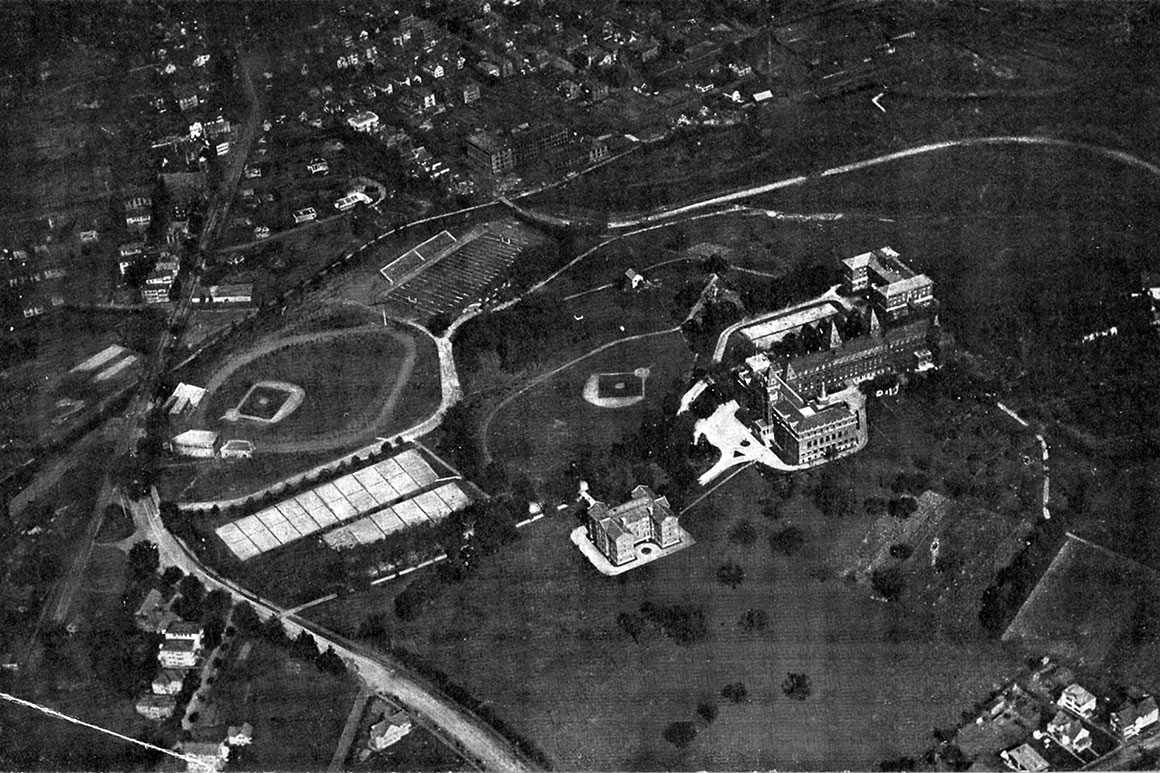
This amazing circa-1918 aerial picture is the first photo taken above Mount St. James. The College’s 174 acres look rather barren bearing only Beaven, O’Kane, Fenwick and Alumni halls. College Street and Fitton Field can also be spotted, as well as Linden Lane. Within the next decade, the campus would see the addition of Carlin Hall (1922), St. Joseph Memorial Chapel (1924) and Dinand Library (1927).

The latest facilities to join today’s campus map include Williams Hall (2003), Figge Hall (2011) and the Hart Center at the Luth Athletic Complex (2018). While this current drone photograph can’t completely match the scope of the original due to altitude limitations, it provides a look at the significantly changed landscape.
A Long-Awaited Achievement
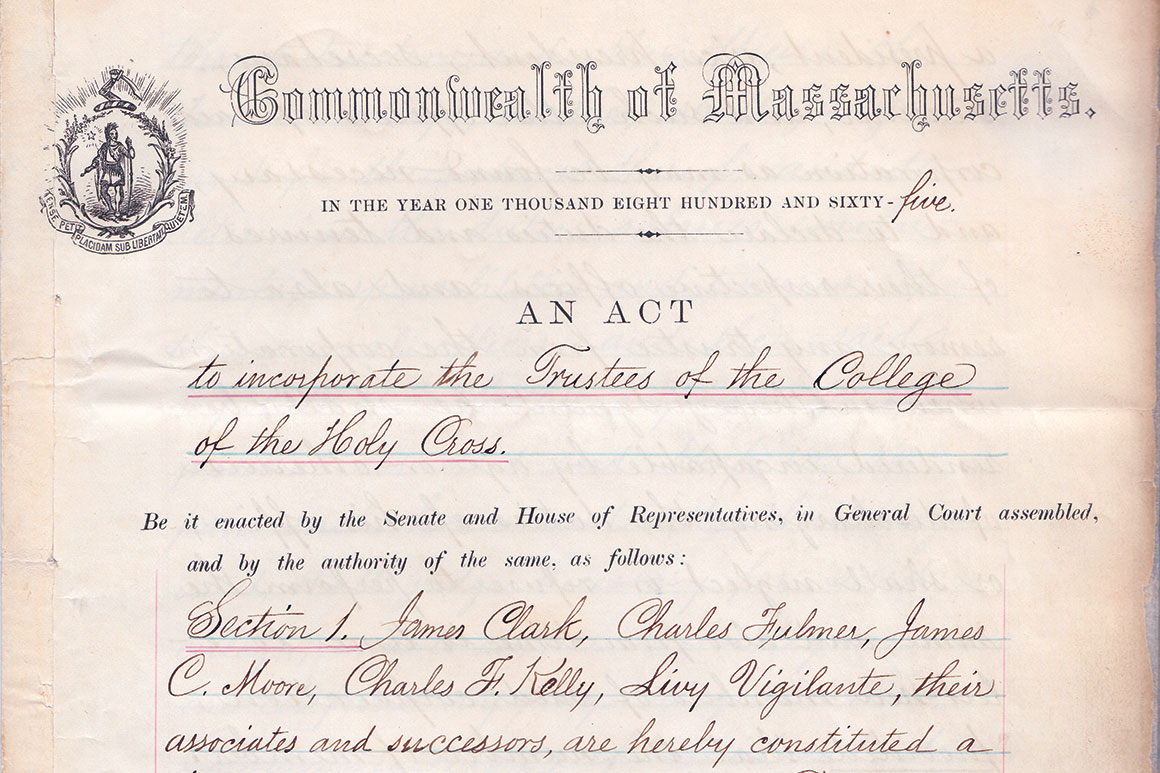
Although the College was founded in 1843, its charter application wasn’t approved by the state of Massachusetts until March 24, 1865, despite an earlier attempt in 1849. In “Thy Honored Name,” Fr. Kuzniewski noted that reasons behind the first rejection included legislators questioning the need for another private college in the state, a campaign to promote enrollment in the state’s public colleges and anti-Catholic sentiment.
Section 4 of this handwritten copy of the charter states: “The clear rents and profits of all the estate ... shall be appropriated to the endowment of said college, in such manner as shall best promote virtue, piety, and learning in such of the languages and of the liberal and useful arts and sciences …” After the charter's approval one faculty member noted: “Holy Cross is no longer a secondary branch of Geo[rgetown].”
The Historian
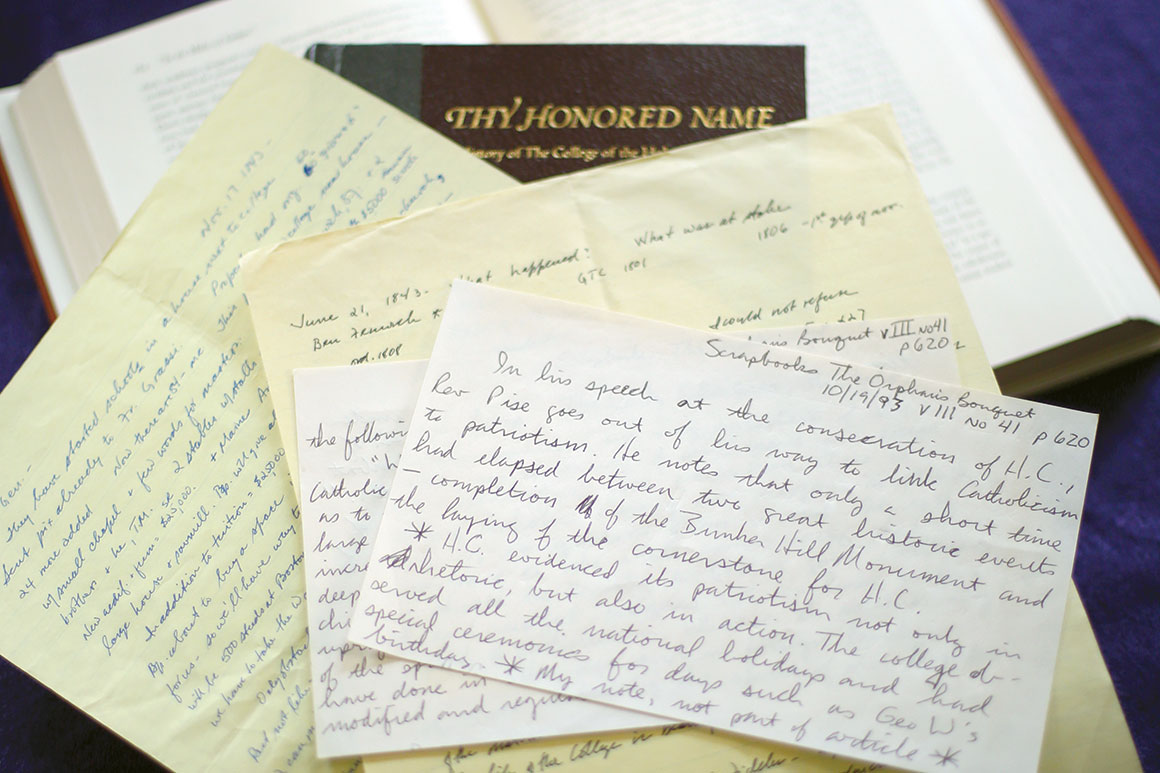
It’s hard to imagine anyone more suited to write the definitive history of the College than beloved history professor Fr. Kuzniewski. For nearly 40 years, he served as College historian, mentor, chaplain, professor and storyteller, a man who helped countless members of the Holy Cross community see their day-to-day experiences as pieces of the larger narrative of their lives. And, perhaps, he told no story as well as he did the College’s in “Thy Honored Name: A History of the College of the Holy Cross, 1843-1994.”
For a small school, the College has a massive amount of history, and Fr. Kuzniewski's 12 years of research and writing — evidenced by these handwritten notes for Chapter 1 — resulted in the 1999 publication of the 516-page book that is the authoritative source for all things Holy Cross.
Healy's Seminal Stripes
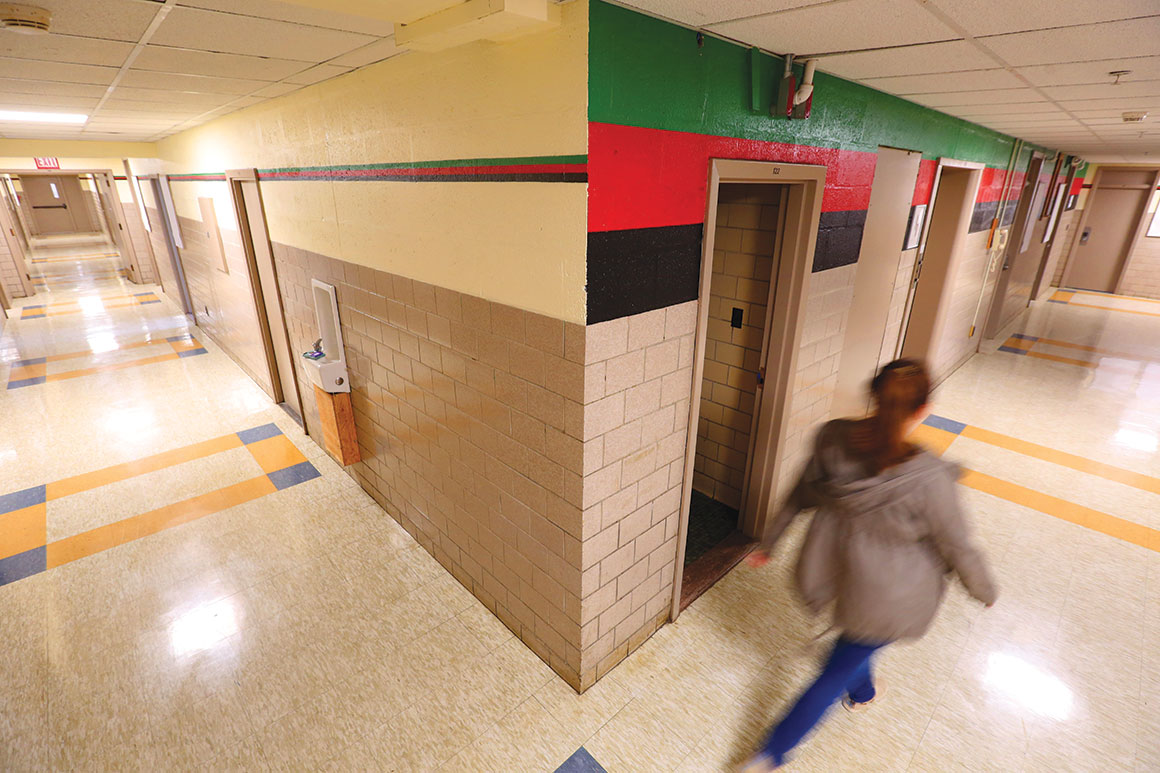
The African-American students recruited to enroll by Rev. John E. Brooks, S.J. ’49, lived scattered throughout campus their first academic year, a situation they found lacking; the majority wanted to live together to provide a sense of community and support. College officials approved the idea of a shared space and “The Black Corridor,” as it was known, was established on the fourth floor of Healy Hall in fall 1969.
“The ‘Corridor’ was an agreed-upon housing arrangement that allowed students of color, including incoming freshmen, to have a choice in whether they wanted to room with a student with a more than likely similar background or be housed with the general population on campus in one of the then-four freshmen dorms,” says Rodney DeLeaver ’74. “The general consensus was that living arrangements played a role in a student’s ability to successfully navigate the initial year in what may be a cultural shock and deterrent to some. It was generally seen as a successful peer support mechanism by many of us entering campus between 1970 and 1985.”
Due to an increase in the enrollment of African-American students the following year, The Black Corridor moved to Healy's third floor, which soon sported the red, black and green stripes of the African Liberation Flag painted on its hallways. Also known as the Pan-African flag, the colors represent the blood shed by all people in the struggle for inclusion and liberation (red); unity aspired by the color of pigmented skin (black); and the land, growth and natural fertility of Africa (green).
Today, the painted stripes remain, but two floors down on Healy 1.
A Treasured Relic
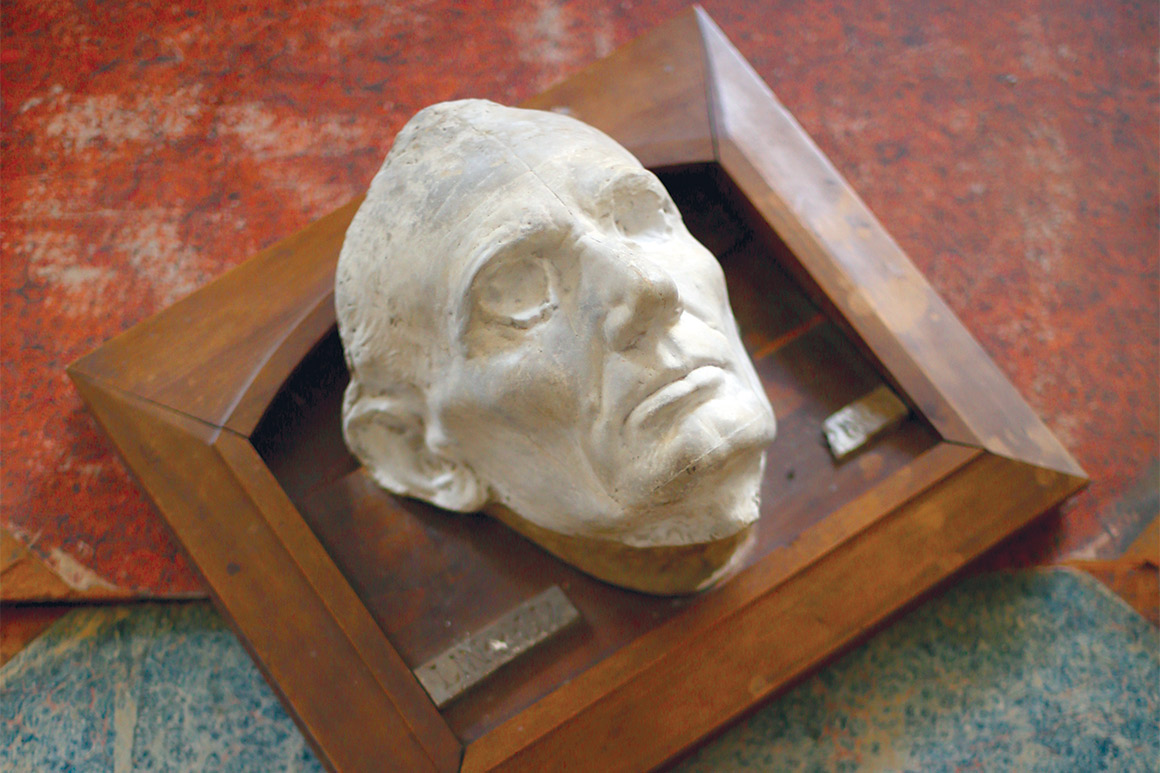
The College is home to a considerable number of irreplaceable and unexpected treasures, such as this rare reproduction of a life mask of former President Abraham Lincoln and a cast of his hands, both of which reside in the College Archives. While many death masks were made of Lincoln, fewer than six were made during his life, including this one by sculptor Leonard W. Volk.
The mask and the hand casts were made in separate sittings in spring 1860, with his hands cast the day he received the Republican nomination for president. Lincoln’s right hand, swollen due to continual handshaking during the day, holds a piece of a broom handle at the sculptor’s request. Both the mask and the casts were a gift from the family of Maurice F. Reidy ’27.
Leafy Legacy
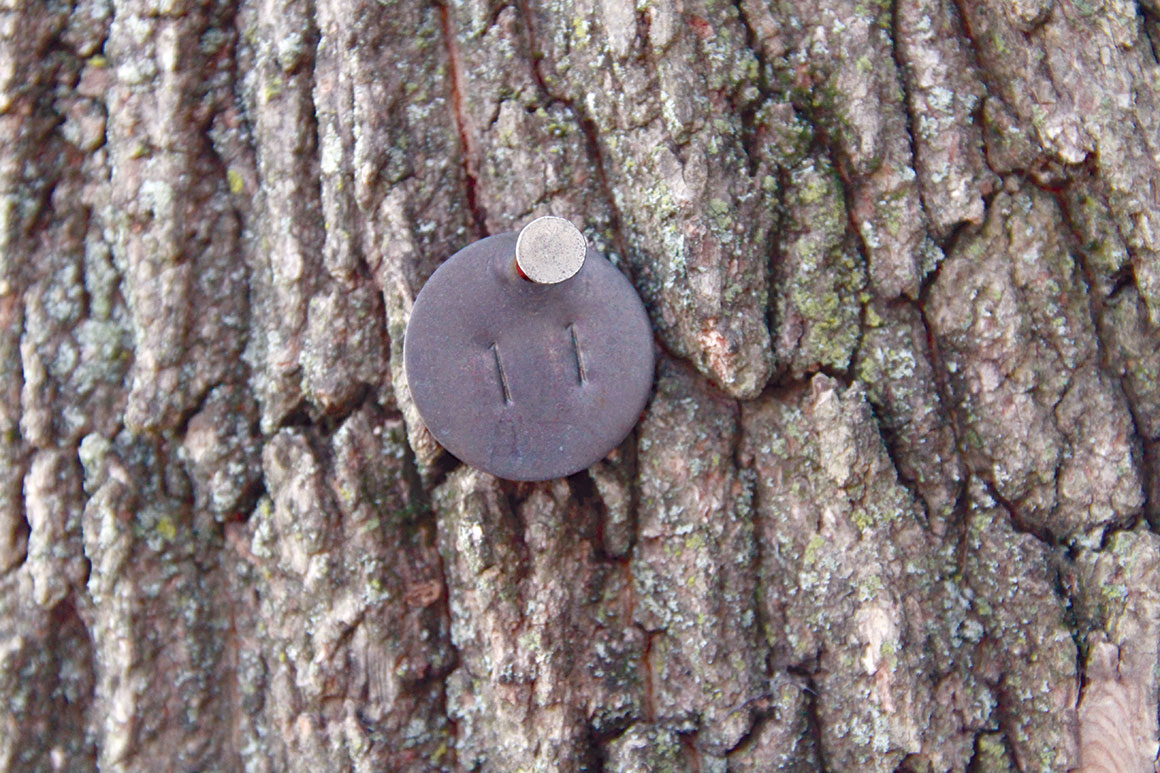
Many trees on campus sport metal tags — 700, in fact. In fall 1983, the campus was officially named an arboretum, a place where a variety of trees and shrubs are grown for study and display. At that time, there were 778 trees and shrubs on campus. Today, there are more than 6,000 representing 115 different varieties. The College community and members of the public can tour the arboretum, which spans the entirety of campus, throughout the year.
Most tags list information that correlates with an accompanying guide, but a handful represent important moments in the College's history. You can read a book under the Teddy Roosevelt Tree near the tennis courts, for example, which the president planted in 1905 when he gave the commencement address. The President Lyndon B. Johnson Tree also stands near the tennis courts on Fitton Avenue, dedicated when the 36th president of the United States delivered the commencement address in 1964. Johnson stepped in following the assassination of President John F. Kennedy, who was slated to be the original 1964 commencement speaker.
Changing Spaces
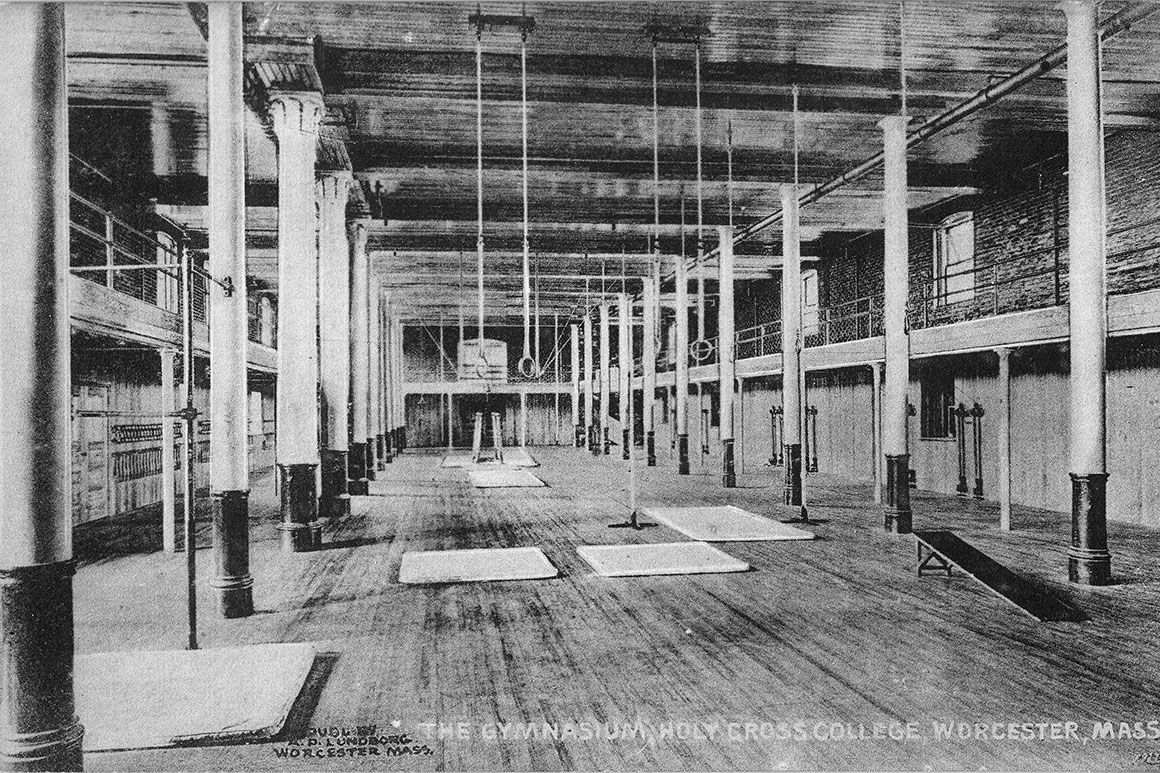
The College’s oldest buildings have adapted as required over the years, serving multiple purposes and transforming to meet the needs of students and staff. A good example is O’Kane Hall, which debuted in 1895, offering, among other amenities, a basement gymnasium, “one of the largest in New England, 139 feet long, 50 feet wide and 29 feet high,” according to the 1906-1907 College Catalog. “It is equipped with all the apparatus usually found in modern gymnasiums. A running track, one-seventh-tenths of a mile in length, elevated about 10 feet from the floor, skirts the entire hall. Off the main gymnasium, shower baths and lockers are provided for students.”
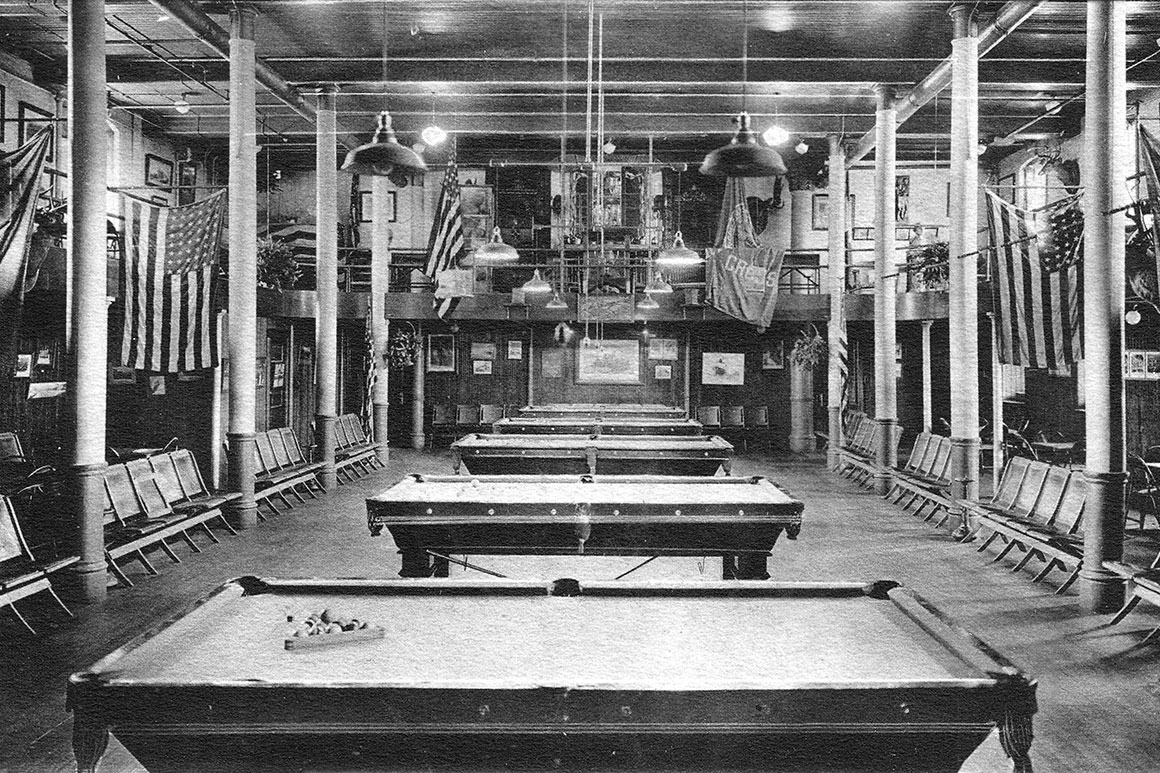
In 1929, part of the gym space transitioned into “a social and recreational hall,” according to a passage in “Thy Honored Name”: “A brochure urged students to respect the usage and cleanliness of the space and to conduct themselves appropriately: ‘Only the workmen, for instance, may wear their hats; and slouching attitudes, etc., are relegated to places remote from the college and to men who do not attend our school.’” Today the area is known as The Pit and is used by the theatre department for acting, design and directing classes, as well as guest artist performances.
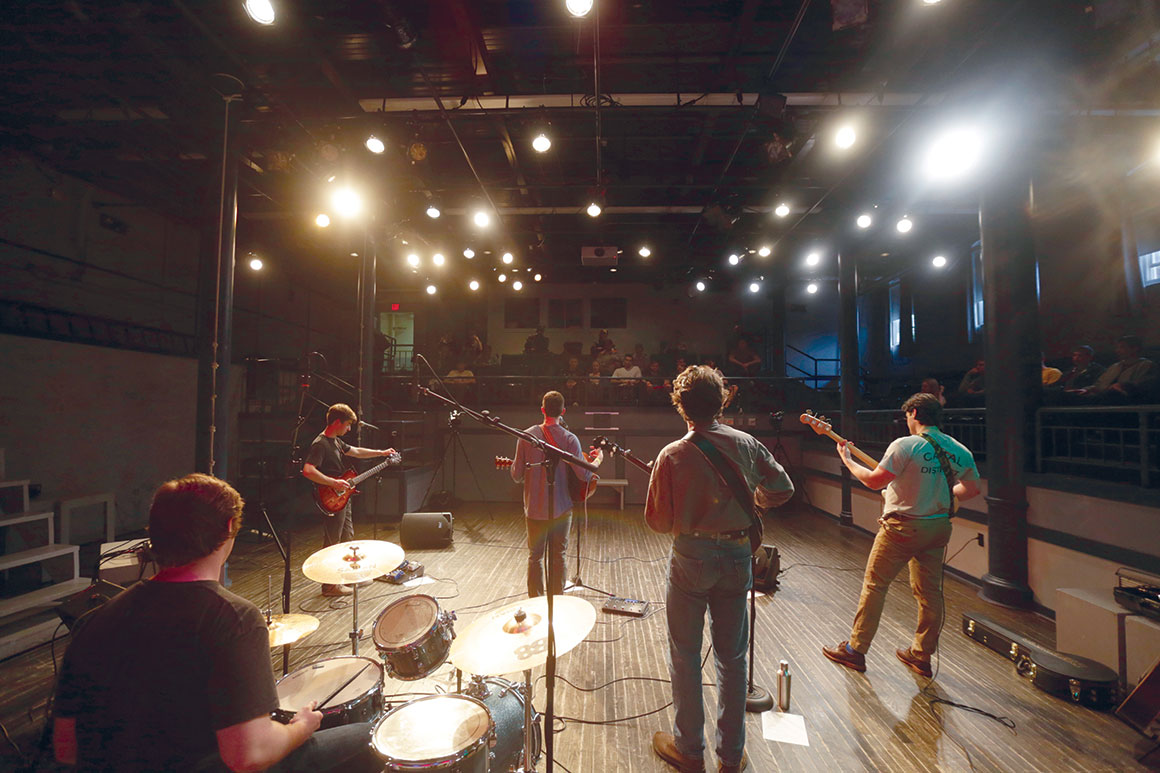
A True Treasure
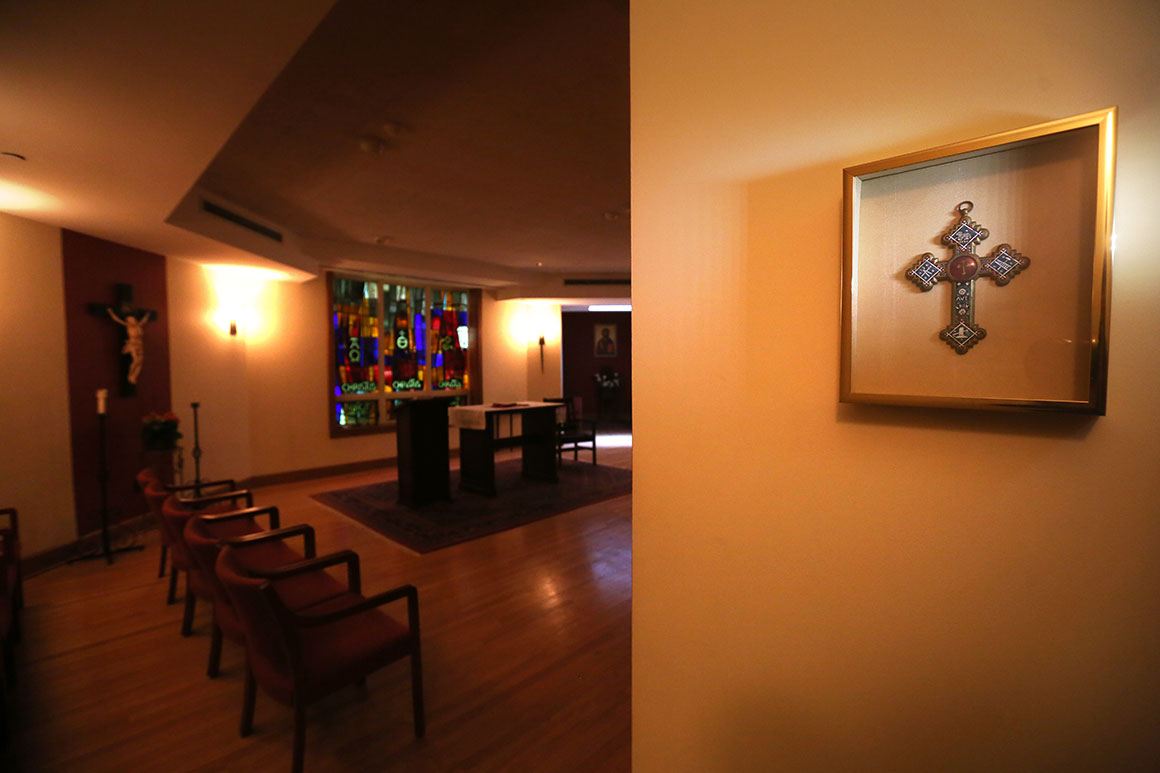
This gilt and enameled cross housed in the Ciampi Hall chapel contains a relic “of the true cross on which Christ was crucified,” according to a May 3, 1901, story in The Worcester Post. The paper reported that through the efforts of seminarians studying in Rome — who were also members of the Holy Cross class of 1896 — the relic was gifted to the College by Pope Leo XIII. The relic traveled from Rome to New York by a papal count, and from New York to Worcester by Rev. C.C. Jones, S.J., of St. Francis Xavier College. In the May 2 minister’s house diary entry, Rev. John Harpes, S.J., noted the cross “is now exposed in the Boys' chapel.
Hallowed, Hollow Steps
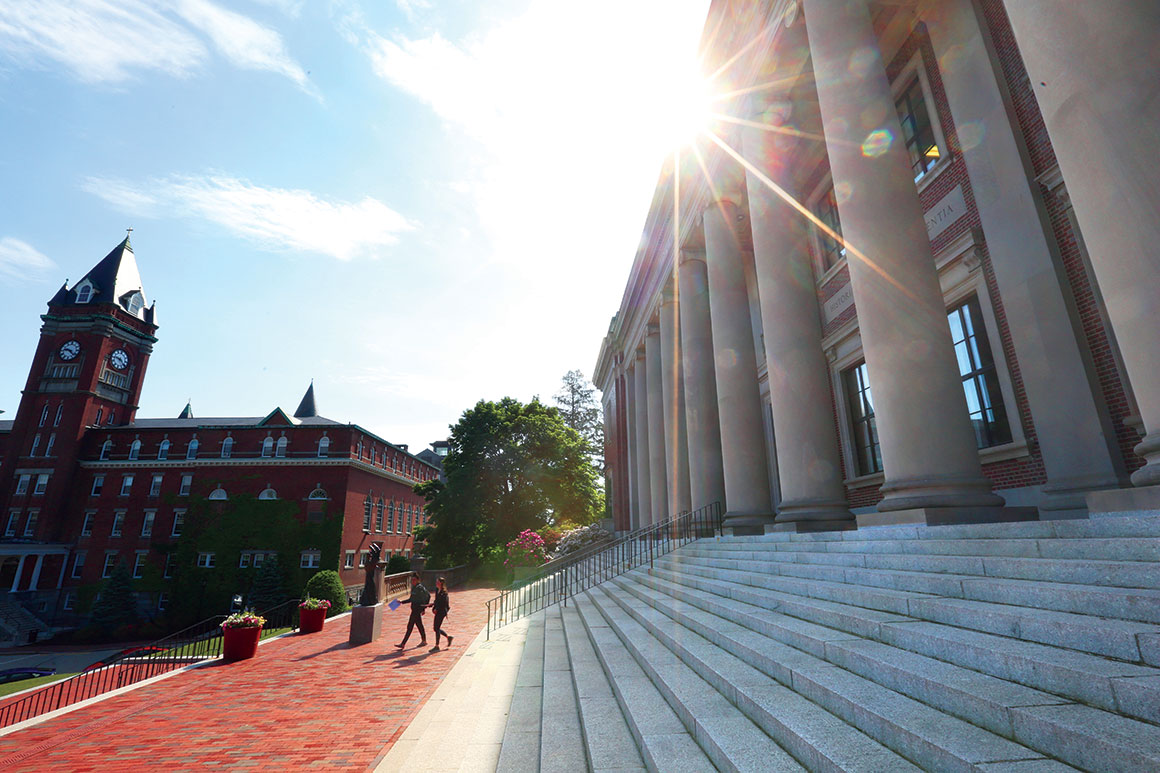
The striking stairs that lead into Dinand Library contain a secret that may surprise: They're hollow. The final stretch of granite steps that lead to the main entrance extend over a hollow space in the basement of the building. Tucked behind an unassuming locked door, the large area, which runs the width of the steps, sports a dirt floor, no heat and is lit by a few bare hanging bulbs. It houses old electrical equipment and several massive pillars that support the 91-year-old building
A Long Day
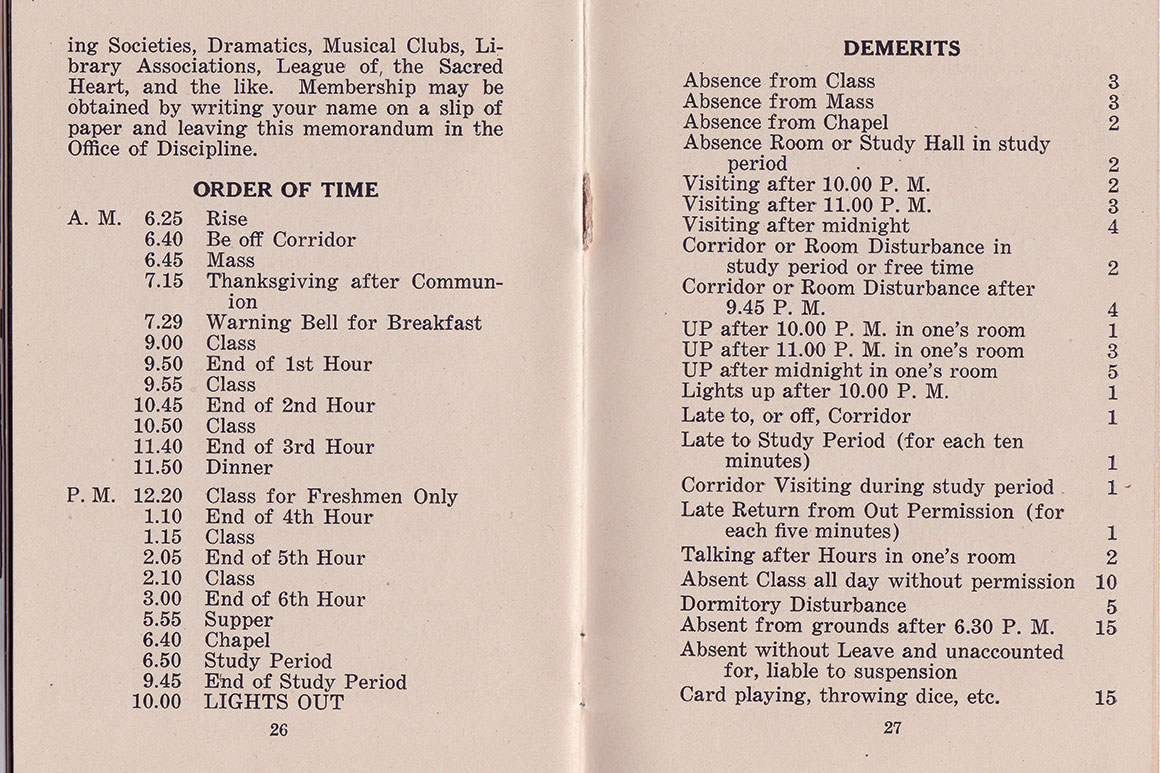
The September 1927 “Holy Cross College Rules and Regulations” booklet issued to students laid out an ambitious day. In addition to a full schedule of classes, meals and prayer, there was apparently plenty of time to get into trouble, as evidenced by the demerits page, ranging from -1 for “Lights up after 10 p.m.” to -15 if caught “Card playing, throwing dice, etc.” The guide also outlines a series of prohibited endeavors around campus, from the chapel (“There should be no trifling, talking, looking about, lounging or the like”) to residence halls (“IT IS POSITIVELY FORBIDDEN TO BRING LADY VISITORS, EVEN MOTHERS AND SISTERS, TO ANY OF THE CORRIDORS WHERE THE PRIVATE ROOMS OF STUDENTS ARE LOCATED”).
Crusaders of the West Coast

The 1969 Holy Cross football team gained national attention when its season was abruptly cancelled after two games. Ninety of the team’s 97 players and coaches succumbed to an outbreak of hepatitis A, contracted after drinking water from what was later determined to be a contaminated practice field faucet. After announcing the season was over, 55 players were quarantined in Hanselman Hall to recuperate.
While the athletes were crushed by the loss of their season, the men found a silver lining in their joint disappointment: the camaraderie and strengthened bonds that developed from their unique situation. Co-captain Bill Moncevicz ’70 says support was high for the athletes, from those across the country to everyone on campus, including the well-wishers who would leave treats outside Hanselman: “They’d leave them outside the door, and we’d stick our arms out and pull them in,” he laughs.
That support extended all the way to California, as the Sacramento State football team dedicated its season to their Holy Cross brethren. For the last game of the season, the team wore the Crusaders’ purple jerseys and invited co-captains Moncevicz and Tom Lamb ’71 to California, where they watched the game in person. “The game was great. It felt like you were actually playing in the game while you were yelling and screaming on the sidelines,” says Moncevicz, who became good friends with the Sacramento lineman who was wearing his number. After the game, Moncevicz received the game ball (left), signed by the Sacramento State players and inscribed: Holy Cross 49, Puget Sound 24.
To this day, Moncevicz has no idea why Sacramento State chose to honor the team in this unique way, “other than the fact there is a fraternal type of relationship between football players all over the country,” he says. “They just happened to say, ‘You know what? We’re gonna give them a chance to actually have a season.’”
'A Good Deal of Psychology'
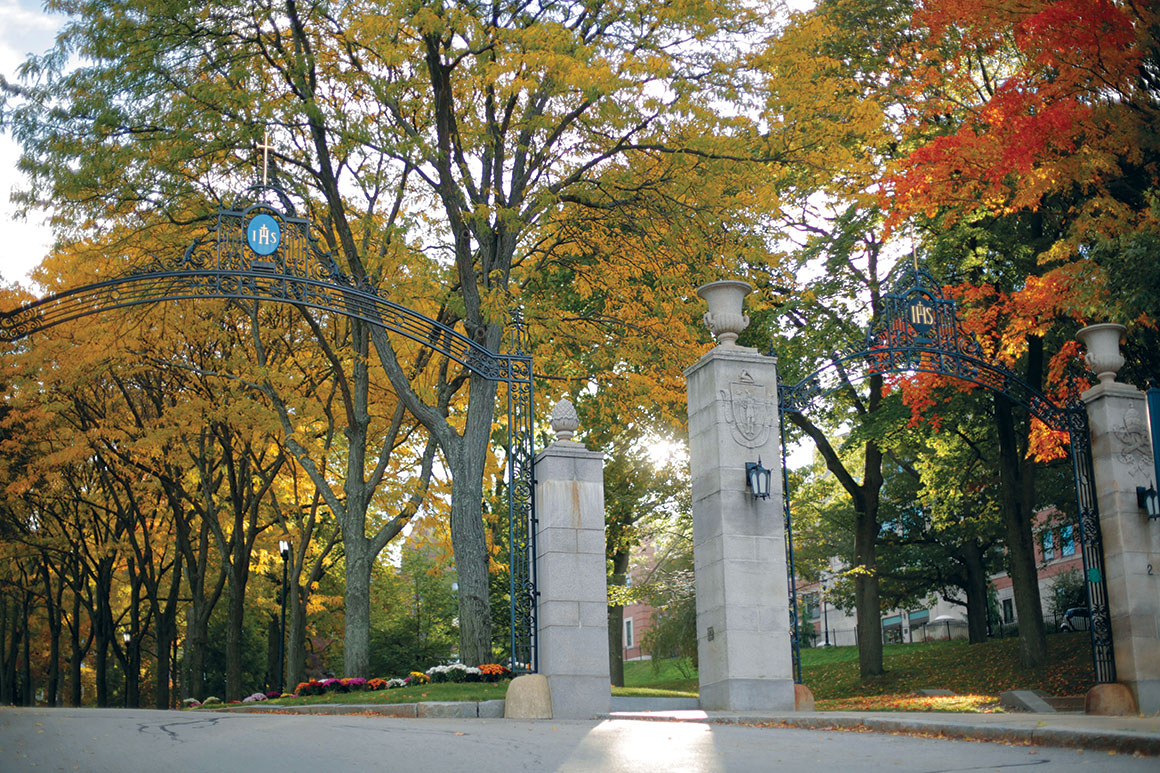
A diamond jubilee gift from the class of 1907, the gate is the College’s unofficial front door, leading to leafy Linden Lane. At 24 feet wide and 23 feet tall, it bore an estimated cost of $4,880; these original 104-year-old blueprints also outlined touches such as "1 coat red lead & 2 coats black paint" and “bronze cross & bronze letters (IHS)."
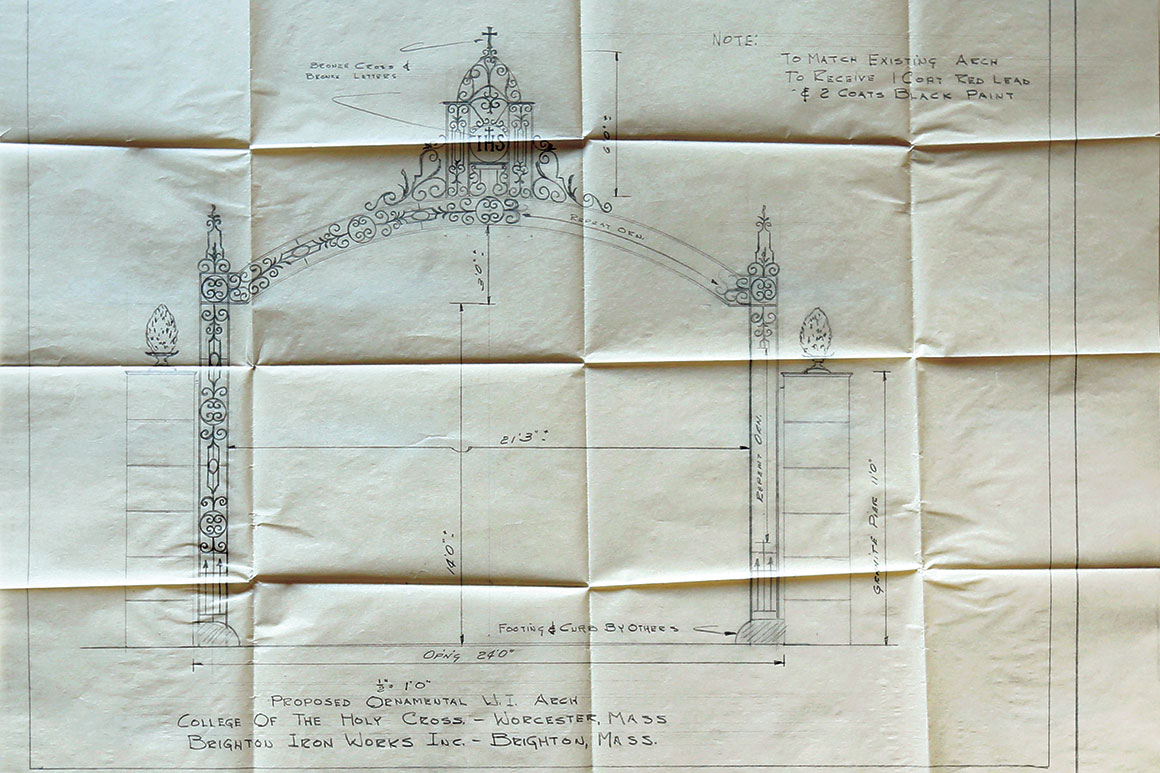
In a Feb. 28, 1914, letter to Rev. Joseph Dinand, S.J., College president, architects Maginnis & Walsh of Boston wrote: “We are sending you, herewith, a blueprint showing the result of a number of studies on the proposed new entrance gates at Holy Cross College. We have endeavored to impart as much stateliness as possible in the scheme, feeling that a good deal of psychology is mixed up with architectural gateways …” In 1959, it was joined by an exit gate, a gift of that year’s class.
A Nobel Achievement

On Dec. 23, 1954, Joseph Murray, M.D., '40 performed the world’s first organ transplant when he removed a kidney from a healthy 23-year-old man and implanted it into his twin brother who was suffering from kidney disease. The successful surgery marked the beginning of a new era in medicine.
Since then, more than 400,000 lives have been saved by transplant surgeries. Murray, a philosophy and English major, was awarded the Nobel Prize in physiology or medicine in 1990 for his achievements in this field; the prize was shared with bone marrow transplant pioneer E. Donnall Thomas, M.D.
The 23-carat gold medal features Alfred Nobel in profile and the years of his birth and death. The diploma, received directly from the hands of the King of Sweden, states the recipient’s name and a citation, in Swedish, of why he or she received the prize.
A Golden, Purple Knight
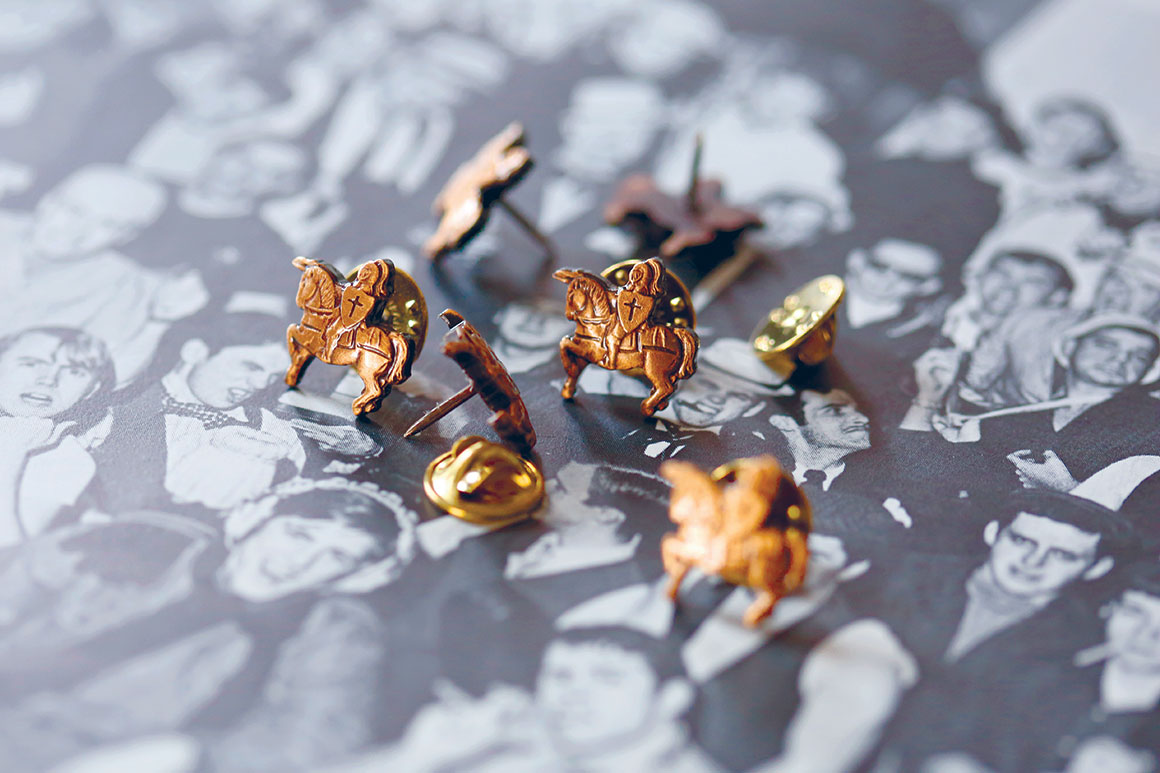
These pins are the mark of a Purple Knight, an honor bestowed on alumni when they reach their 50th reunion. The tradition began in 1974, with the 50th reunion of the class of 1924. This year, 540 members of the class of 1968 were inducted into the Purple Knights on June 8 at Reunion.
At a dinner celebrating their golden jubilee, College President Rev. Philip L. Boroughs, S.J., invited the members of the class to fasten the pins to their lapel, officially inducting them into the Order of the Purple Knights.
3D Chalkboard

A frequent sight in former physics and mathematics courses, chalk globes were used to illustrate spherical geometry, with this one still residing in Swords Hall.
A Commencement Mainstay

Holy Cross’ hand-crafted silver mace was presented to the College in 1984 by blacksmith Kenneth Lynch Sr., the late owner of Connecticut-based ironwork firm Kenneth Lynch & Sons. In a 1984 edition of “Crossroads,” the precursor to Holy Cross Magazine, Lynch explained that he gifted the mace because two of his brothers were Jesuit priests, and he was a great admirer of Holy Cross. (Lynch also worked on the wrought-iron fence along College Street).
The mace, which the registrar carries at the head of the commencement procession, measures more than 3 feet in length with three layers of polished silver covering its bronze base. The names of the College presidents and their years of service are inscribed on the head of the mace, which features a cross-topped dome. The middle of the mace bears the College’s seal. It replaced the wood and metal mace that was a gift of the class of 1940.
Exceptional Valor
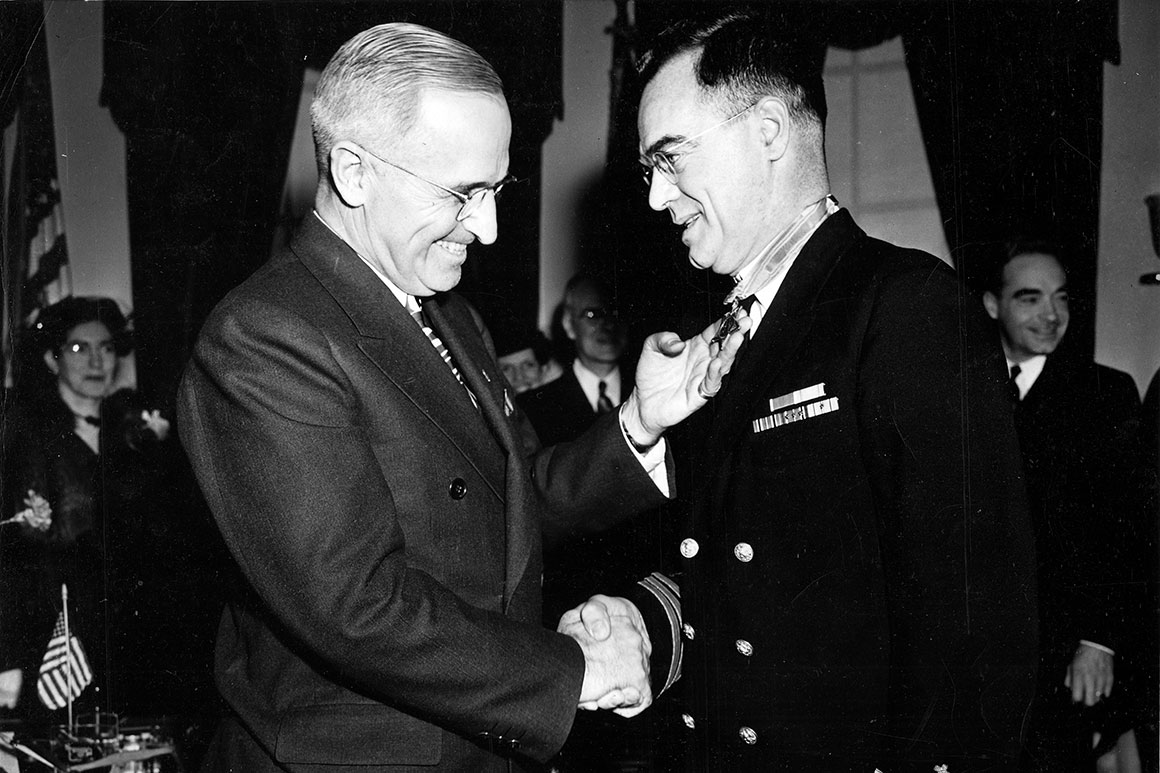
Rev. Joseph T. O’Callahan, S.J., professor of math and physics at the College, was the first U.S. Navy chaplain to receive the Medal of Honor, the nation’s highest decoration for valor, for his service aboard the U.S.S. Franklin in World War II. The O’Callahan Society, made up of Holy Cross alumni who were also members of ROTC, is named in his honor.

Fr. O’Callahan was laid to rest in the Jesuit Cemetery on campus, and while some accounts say he was buried with his medal, it is housed in the College Archives. The medal rests on top of a May 1945 New York Daily Mirror front page, featuring O’Callahan praying over a fallen sailor. The citation of his medal reads, in part:
“For conspicuous gallantry and intrepidity at the risk of his life above and beyond the call of duty while serving as chaplain on board the U.S.S. Franklin when that vessel was fiercely attacked by enemy Japanese aircraft during offensive operations near Kobe, Japan, on 19 March 1945. … Serving with courage, fortitude, and deep spiritual strength, Lt. Cmdr. O'Callahan inspired the gallant officers and men of the Franklin to fight heroically and with profound faith in the face of almost certain death and to return their stricken ship to port.”
Expressive and Sacred Arts

This mythological Balinese creature, Barong, serves as the guardian spirit of a village and is made of a hand-carved wooden mask, a beard of human hair, long fur, feathers, bells and mirrored ornaments attached to gilded leather to reflect the light. The ornate figure commands the stage during performances of Holy Cross' Balinese gamelan ensemble, Gamelan Gita Sari (Essence of Song). Barong is among hundreds of costumes and instruments, including the 25-piece gamelan orchestra, custom-made by master Balinese craftsman and blessed through elaborate rituals before being used at the College.
These items are the physical representation of the Balinese Arts Program's 20-year presence on Mount St. James, which has welcomed some of the world's foremost Balinese musicians and dancers as full-time visiting faculty members to introduce students to the rich traditions of Balinese culture. Through the gamelan music and accompanying dance repertoire, which are a part of Balinese Hindu temple ceremonies, students explore the religious traditions of Bali and its rituals where these sacred — and sometimes secular — performative pieces relate to the arts.
History at the Field House

The College has played host to a variety of notable guests over the years, including a 33-year-old Martin Luther King Jr. who, as a guest of the Cross & Scroll Society, spoke to a packed Field House in November 1962 — nine months before the March on Washington. Steve Bashwiner '63 picked up King and his wife, Coretta Scott King, at the Worcester airport, ate dinner with them and others, and introduced him on stage. As Bashwiner wrote in a 2012 Holy Cross Magazine essay: “When he concluded his remarks, he turned to me and said (I will, of course, never forget this): ‘That's the best introduction I have ever had. You got it just right. We have to all work together to obtain justice for all of us. That is my goal.’”
Who Are You?
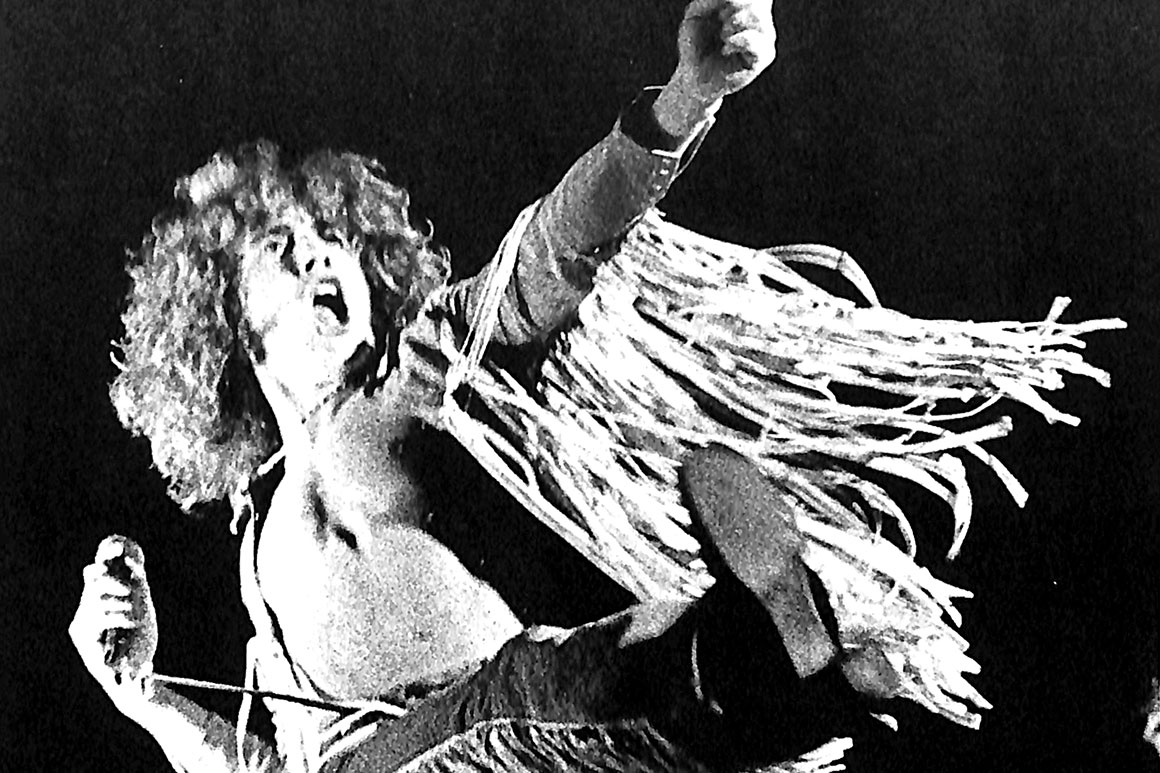
On Oct. 17, 1969, students could see for miles and miles when The Who performed during Homecoming Weekend (even though the football season had been cancelled due to an outbreak of Hepatitis A). Fresh off recording the legendary rock opera "Tommy" and two months after performing at the Woodstock Arts and Music Festival, the band was picking up major steam when the played on Mount St. James.
The London quartet is just one of a variety of high-profile acts that have performed at the College, including Miles Davis, The J. Geils Band, Steve Miller, The Eagles, and artists of today such as Jason Mraz, Guster, Drake and Jessie J.
A Candid Look at Early College Life

Bishop James A. Healy, class of 1849, was a notable figure in Holy Cross history — the College's first valedictorian. He became America's first African-American priest and later the first African-American bishop ordained in the United States.
But in 1848, Healy was an 18-year-old student in his fourth year at Holy Cross and a dedicated diarist. In this diary, which spans December 1848 to May 1849, the Georgia native provides precious, often funny, details on what early College life was like.
He opined on everything from the weather (“The wind has swept the entire hill for the last 2-3 days, keen and cold continually,” “Heard Mr. Riordan preach when the church was so cold, I could not possibly be melted by eloquence”) to studies (“We spent all yesterday’s chemistry class in burning and exploding hydrogen and oxygen gases together,” “We tried to get out of studies but did not succeed”) to classmates (“Neil took a bath today to our great joy,” “Poor Jim McCabe is out upon his knees in the middle of the floor. He is obliged to stay there during two studies to get 40 Latin lines and was confined to the house all day”) to the food (“We rose as early as usual and after hearing a long and dry sermon from Fr. McMullen, went down to breakfast to eat bread soaked in turpentine or the burning fluid”).
The Living Room
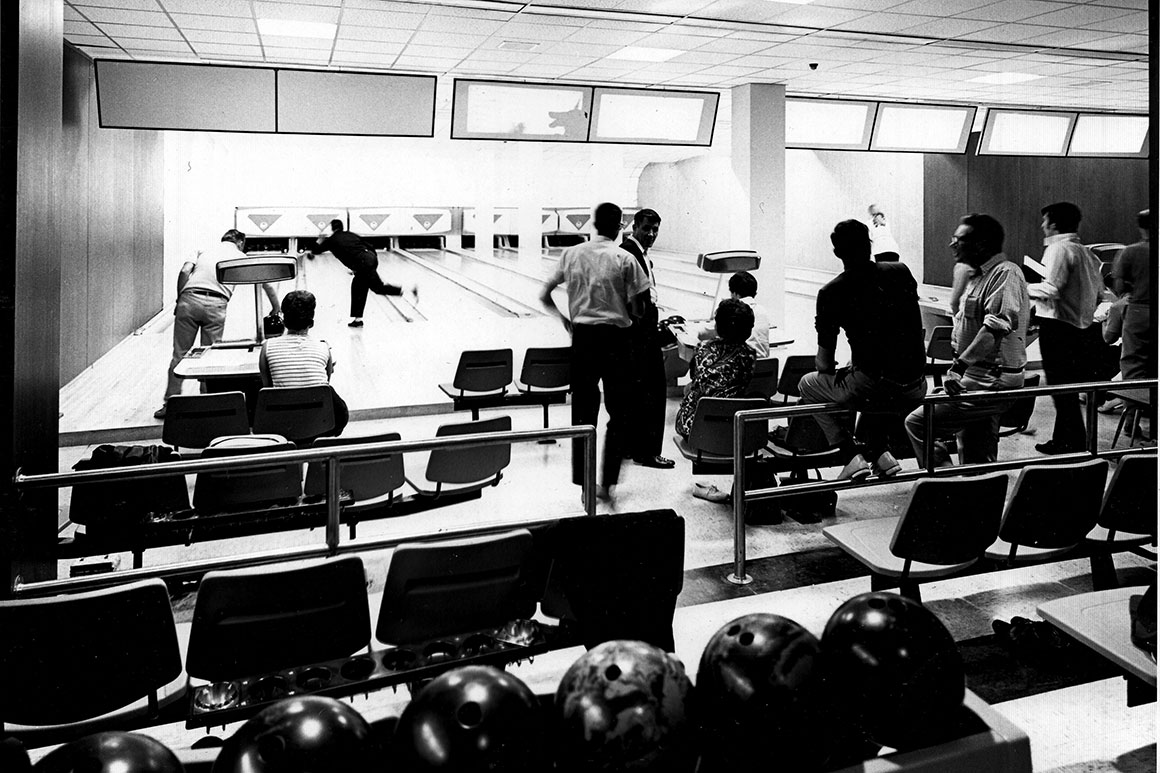
The October 1967 opening of the 120,000-square-foot Henry M. Hogan Campus Center marked a decided shift in student life. With socializing once centered in residence halls and their lounges, student activity moved to the new multistory social and recreational center, which then-College President Rev. Raymond J. Swords, S.J. ’38, termed “the living room of the campus.”
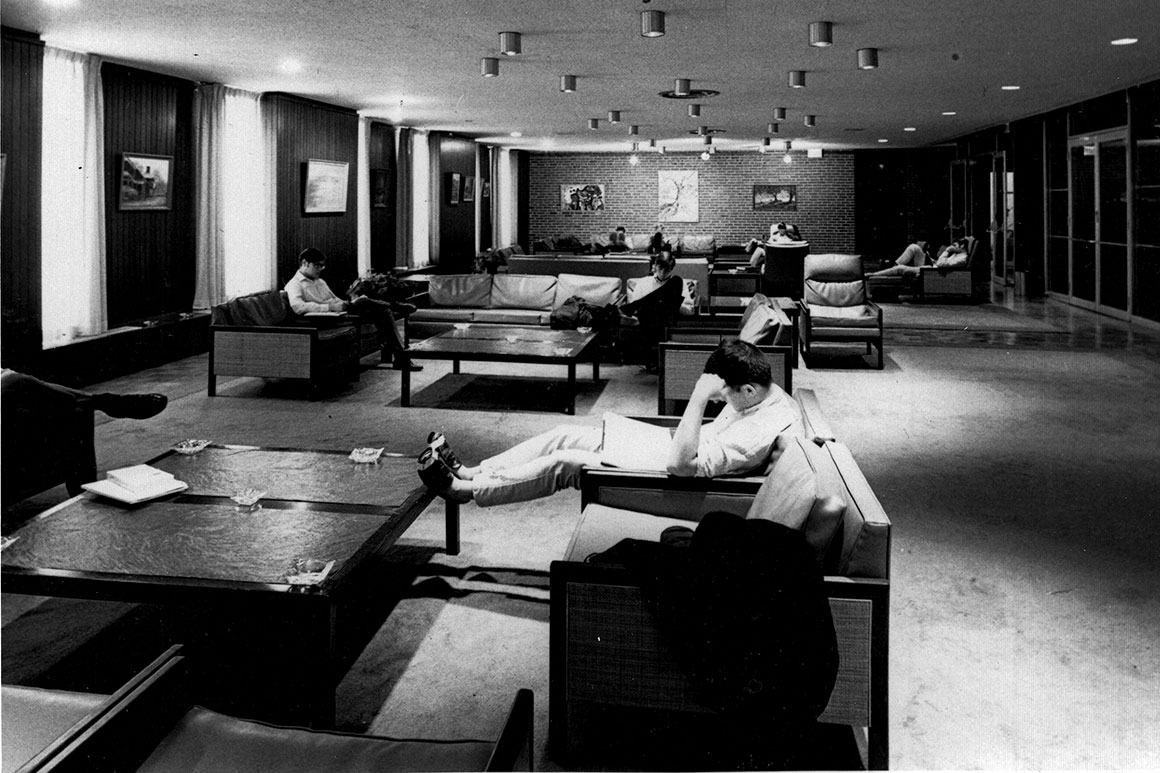
Among the offerings touted in this 1970 Hogan brochure are a fencing room; a second-floor golf room (six-hole putting green and two driving cages); 11 billiard tables (80 cents per hour); seven table tennis tables (40 cents per hour); eight bowling lanes (40 cents per lane with 10- cent shoe rental); and locker rooms (“for the convenience of the day students”).
The Hart of Intramurals
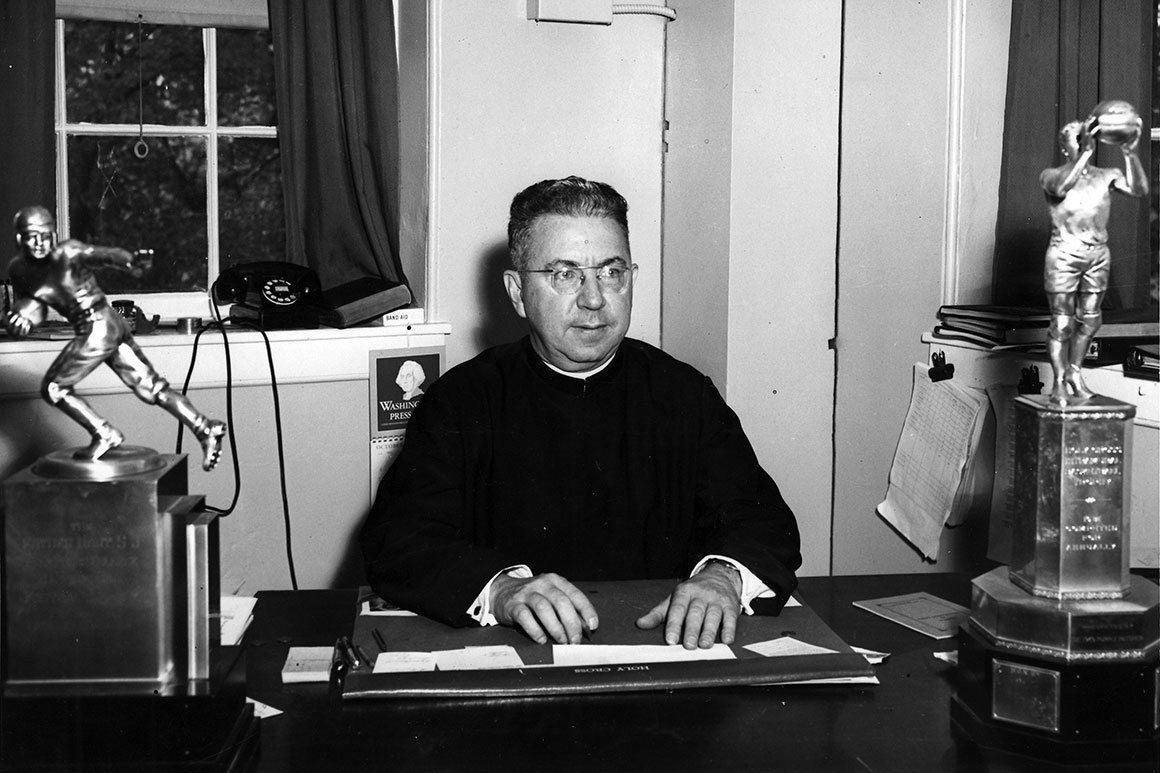
Although intramurals began at the College during the 1930-31 academic year through the suggestion of Rev. Maurice Dullea, S.J., it was Rev. Francis J. Hart, S.J. '21 (above), who was most strongly associated with the non-varsity athletic endeavors of students. Named associate director of intramurals in 1933 and then director in 1943, he was the guiding force behind the program for more than 40 years, until his death in 1986.
The early years of intramural athletics included football, basketball and baseball, and involved teams organized from the residence halls as well as the day students; according to the 1950-51 College Catalog, "intramural sports provide healthful exercises and plenty of fun; cement friendships and develop many positive traits of good character and personality." In 2017-2018, you'd be just as likely to find students competing in innertube water polo or wiffleball as you would basketball or baseball, but the value to students remains the same!
Visible Support
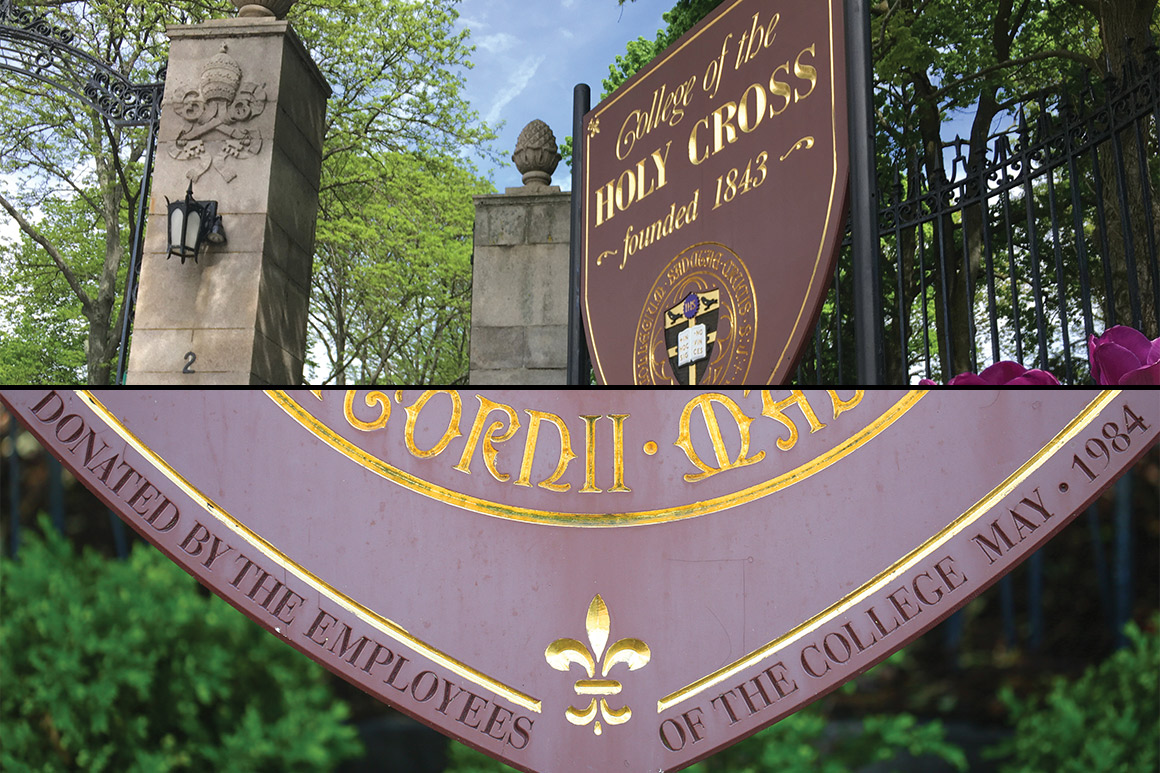
You’ve seen the stately College sign by the Linden Lane gate countless times, but it’s almost impossible to notice one key aspect: The 5-foot by 6-foot sign was funded and donated by the College’s employees, a fact inconspicuously carved in the mahogany near the bottom of the sign.
In an effort spearheaded by the physical plant, employees raised several thousand dollars for the gift in 1984 and noted in the fundraising flyer: “This sign will be a visible and lasting way to show the College our appreciation of all benefits given to us over the entire year.” Today, the College has approximately 1,160 employees who keep it running daily.
A Singular Honor
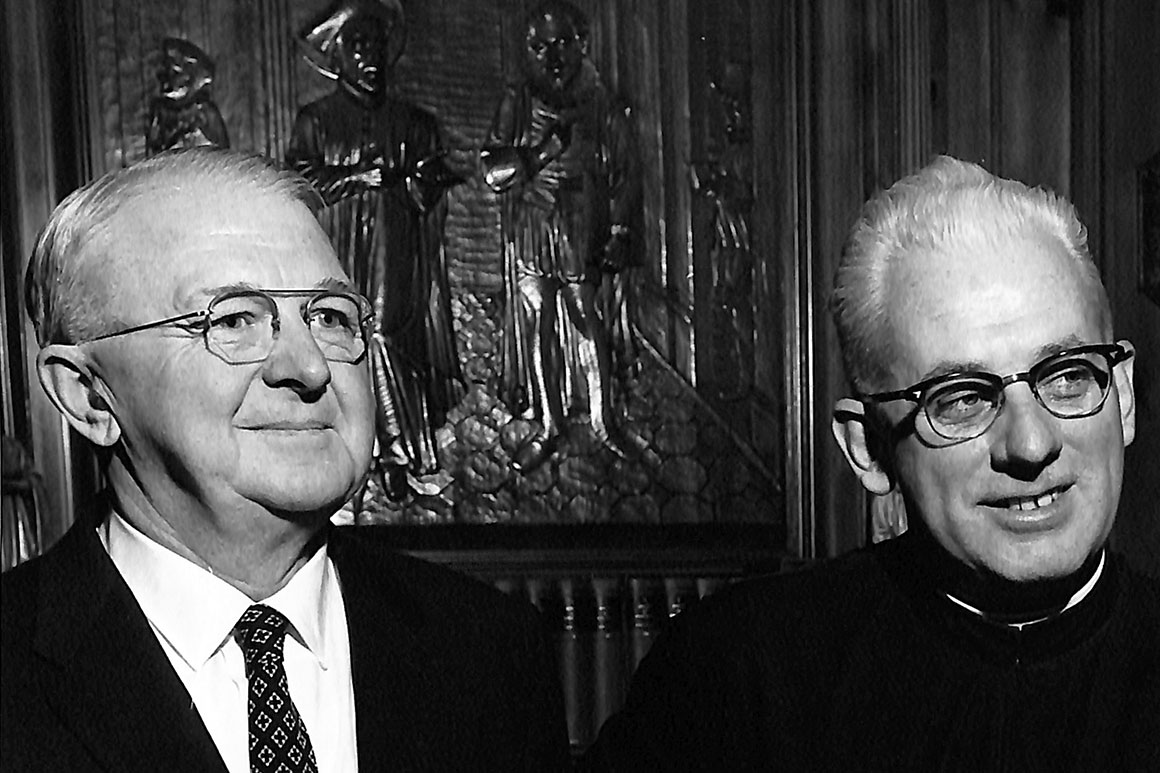
Francis L. Miller is the only lay person buried in the Jesuit Cemetery. The father of the late Rev. Francis X. Miller, S.J. '46 (who served as the College's vice president of development for 22 years), the elder Miller became the College’s first bursar, worked on Mount St. James for 47 years and was a well-loved figure on campus.
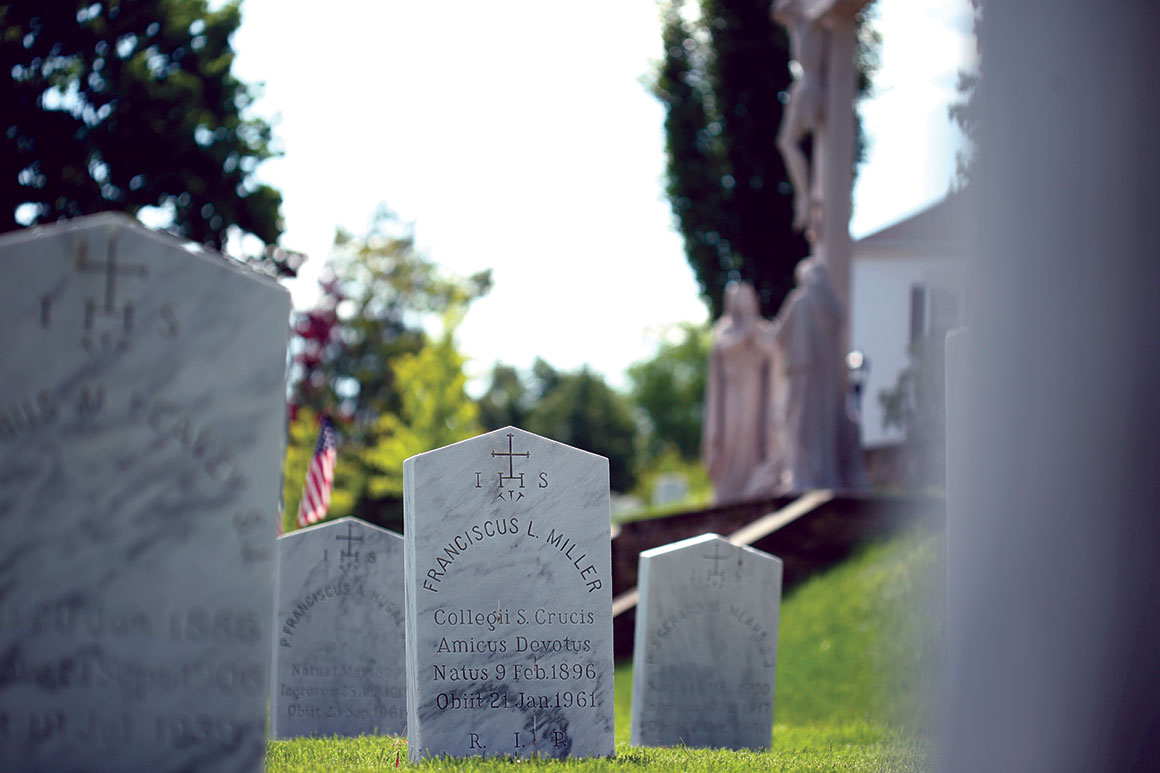
Upon Miller’s death in 1961, then-College President Fr. Swords reached out to family members of the Jesuits interred in the cemetery to see if any had objection to Miller’s burial in the cemetery. The gravestones of the nearly 300 Jesuits and diocesan priests buried in the today almost full cemetery bear their name, date of birth (Natus), date of death (Obiit) and entrance into the society (Ingressus). Instead of the latter, Miller’s reads: Collegii S. Crucis Amicus Devotus: "Devoted Friend of the College of the Holy Cross."
A Transformative Vision
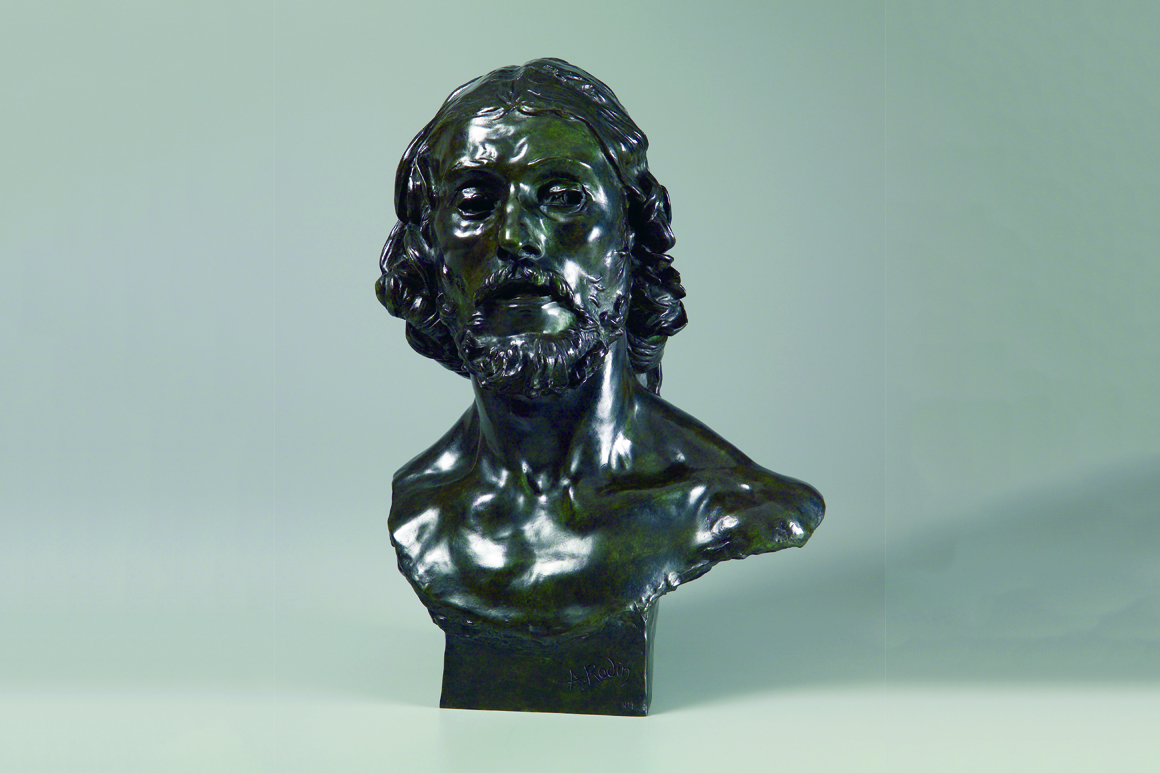
The telltale characteristics of the works of Auguste Rodin — their unfinishedness, expressiveness and realism — stand pronounced in the "Bust of Saint John the Baptist," a bronze casting of the famed artist's sculpture, which flanks the foyer of Dinand Library. The lifelike piece arrived at the College in 1982 and is one of 10 Rodins that call Holy Cross home, thanks to the transformative vision of Fr. Brooks and the donations of famed philanthropists and art collectors B. Gerald "Bernie" and Iris Cantor.
The following year saw the opening of the Iris and B. Gerald Cantor Art Gallery, which now holds nearly 2,000 pieces in its permanent collection and was the first of many Cantor-supported arts spaces in the United States.
"The presence of the gallery on campus affords the entire Holy Cross community an opportunity to experience that artistic beauty which so readily helps us attain the openness and tolerance necessary if we are to understand who we are and how we relate to one another," Fr. Brooks shared at the gallery’s opening.
Pioneering Women
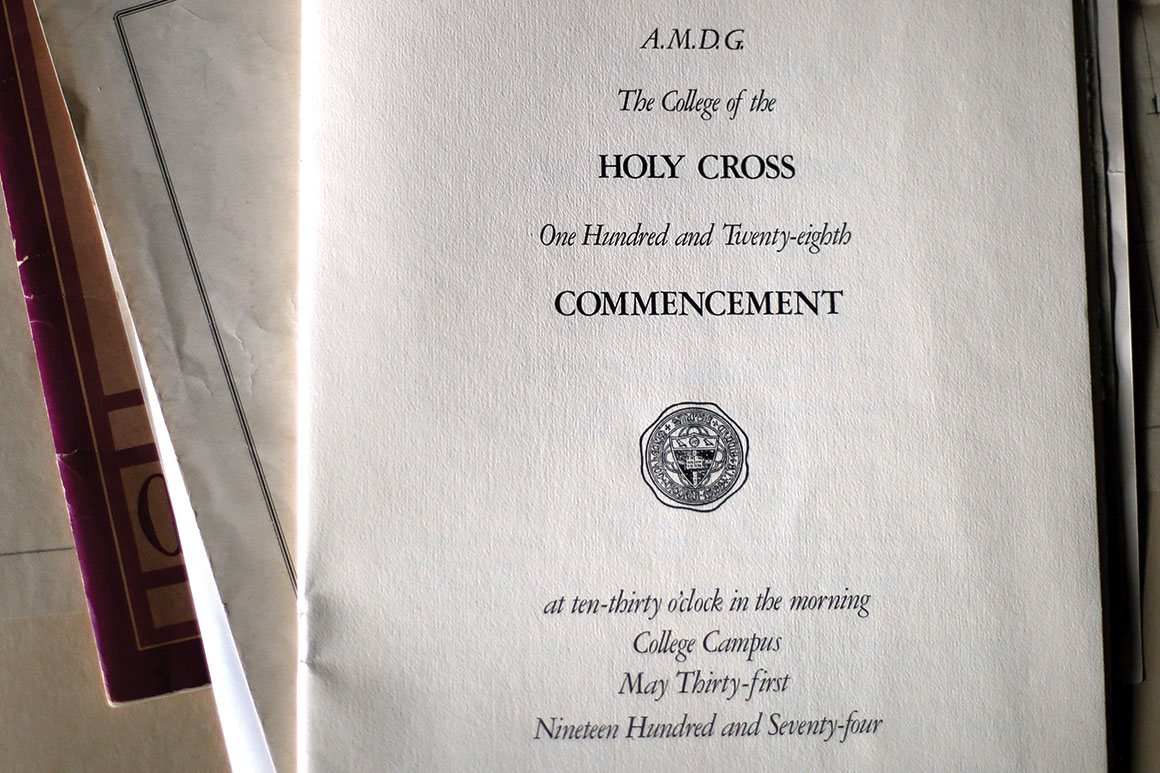
In 1972, the gates of Linden Lane were officially opened to female students. While that inaugural class of women would graduate in 1976, the first female graduates of the College actually walked across the stage in 1974, a group of 15 students who transferred after completing their sophomore years elsewhere. Thus, this program from the 128th Commencement Exercises in 1974 includes the names of the first female graduates of the College.
"The truth is that that first class of women excelled academically from the start," Theresa McBride, a professor of history who joined the faculty in 1973 told the Telegram & Gazette in 2012 during the 40th anniversary celebration of coeducation. "They consistently rose to the occasion of the faculty."
About 30% of the graduating class of 1976 was female, a number that would grow steadily over the years until the Class of 1989 when 58% of the class was female, the first time that more women were accepted then men. As of Fall 2017, the student body on campus across all four classes was 52% female and 48% male.
A Legacy of Diversity
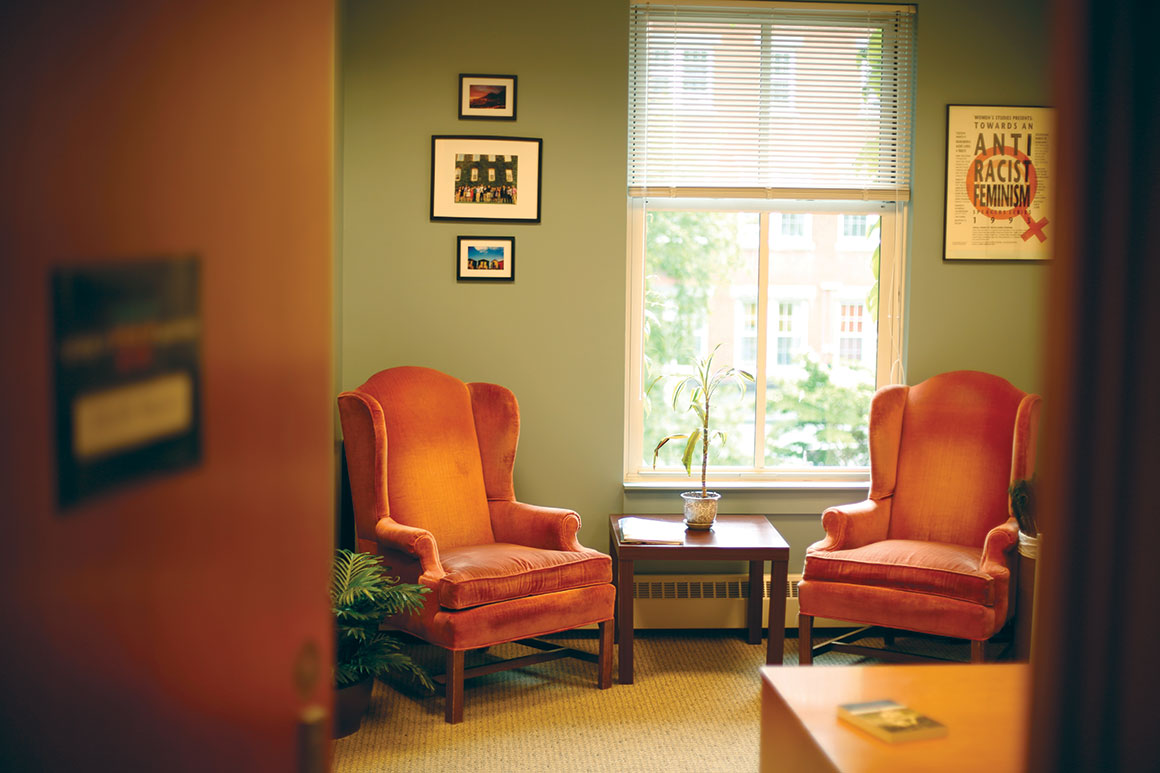
These office chairs originally belonged to Ogretta McNeil, associate professor emerita of psychology, the first woman hired on a tenure track to teach in the psychology department and the first African-American woman to serve on the faculty at Holy Cross. McNeil was a leading figure on campus in efforts of diversity and inclusion, serving as the black student adviser and, then, as assistant dean for academic services for African-American, Latin American, Asian-American and Native American (ALANA) students; in both roles, she was instrumental in developing programs to support ALANA students and create an inclusive community on campus. McNeil passed away in 2016.
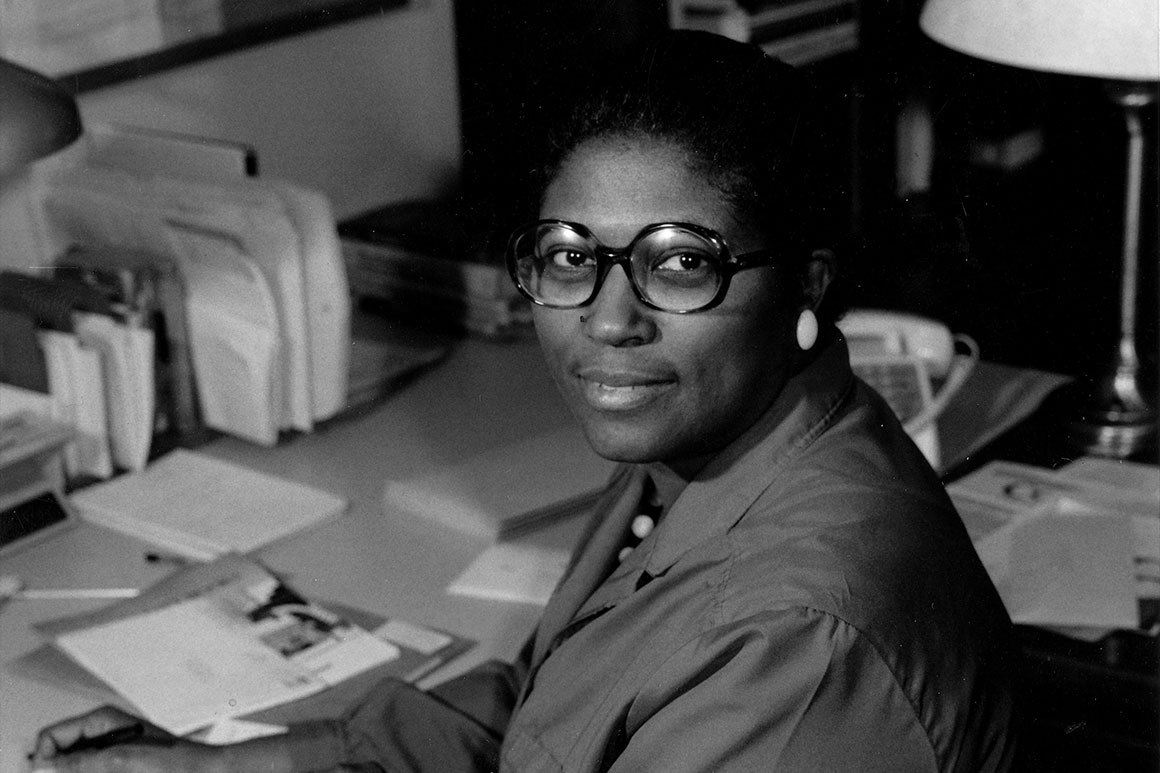
Fittingly, these chairs were next used by Esther Levine, who served as dean with special responsibilities for ALANA students (one of her many roles) and established the Odyssey program, an orientation program for first-year students who are first generation to college, students of color or eligible for the Pell Grant. When she retired, the chairs moved to the office of Greta Kenney, now director of the office of diversity and inclusion.
"I moved offices from Hogan Campus Center to Smith Hall a few years ago, and I was lucky enough to inherit Ogretta's chairs. When I learned the history of the chairs — that they were Ogretta's in Fenwick, and then Esther's in Fenwick, and then Esther's in Smith, and that over the years they both had to fight to keep them from being replaced — I thought, 'I am not worthy,'" Kenney explains.
"Ogretta and Esther did such invaluable, transformative work at Holy Cross, supporting and advocating for historically marginalized students while simultaneously carving out paths for women of color in the faculty and administration at the College. The chairs are these well-loved, burnt-coral, high back winged armchairs that you might find in your grandmother's den, and I like to think of them as having a diversity and inclusion legacy. It's humbling to think of everyone who has sat in them over the years — every conversation that has taken place: the successes, failures, triumphs and moments of self-actualization and empowerment. I feel privileged to be a part of continuing the work that Ogretta and Esther started," Kenney adds.
The student body has evolved dramatically since McNeil first began her role as dean in 1984. Although ethnicity figures are not available for those earlier years, records show that 7.2 percent of students identified as ALANA 10 years later. By fall 2017, nearly one-quarter (23.1 percent) of students identified as ALANA. During the same period, international enrollment expanded from just .5 percent of the full-time student body to 3.2 percent this past academic year.
"Give Another Hoiah"
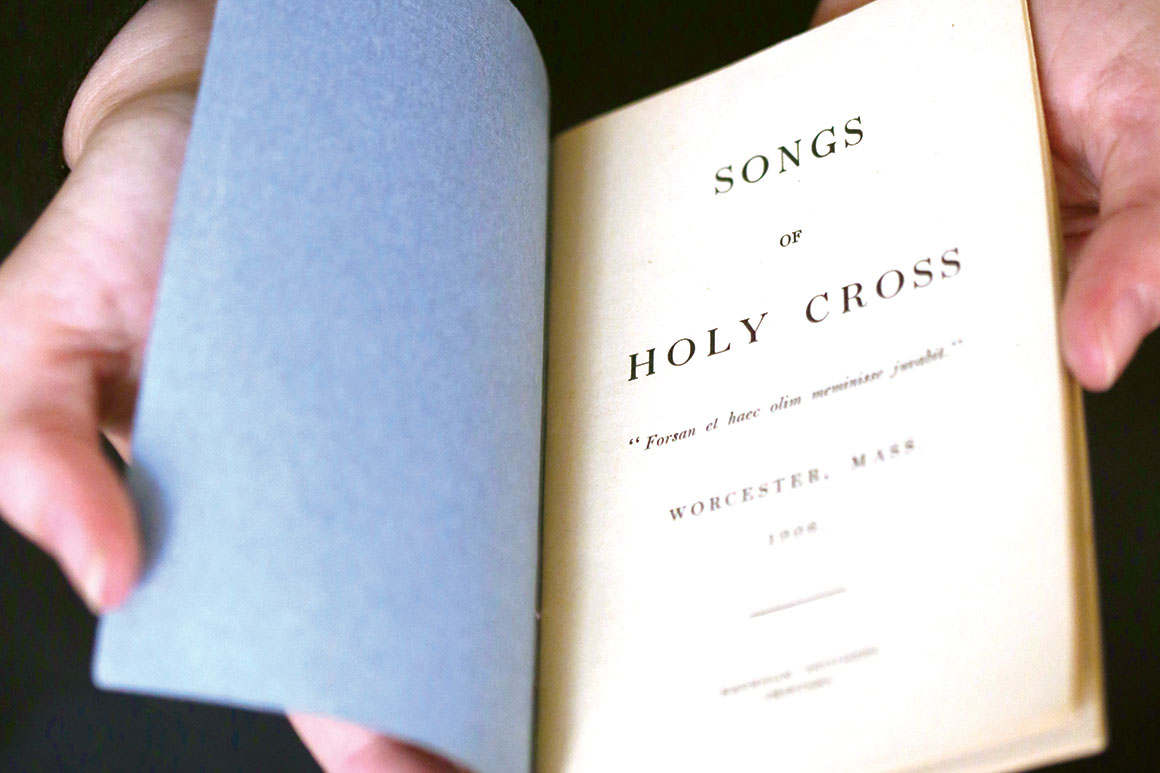
This 1906 songbook is a collection of the many songs of Holy Cross, including "Stick to H.C.C.," "Holy Cross, Old Holy Cross" (now "Alma Mater") and, of course, "Chu-Chu, Rah, Rah!" The songbook groups the tunes into "Class and Occasional Songs" and "Field Songs." There are even some clever plays on popular songs, including "Give My Regards to Broadway" rewritten as a taunt to Harvard and Dartmouth: "Give our regards to Harvard/Remember us to Dartmouth, too/Tell all the other college baseball teams/That we'll make them skiddo…"
Take a look inside the songbook!
A Distinctive Honor
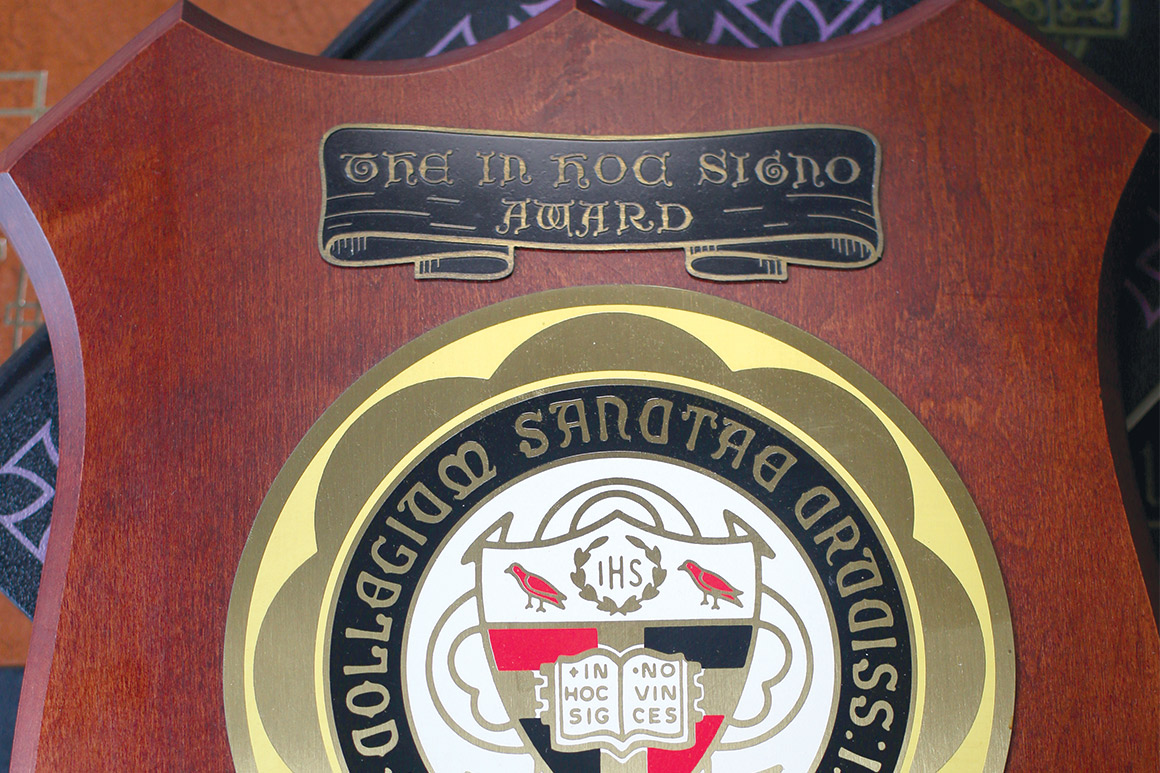
Each year, Holy Cross honors up to four graduates with the In Hoc Signo Award, the Alumni Association's highest honor, as an expression of respect and admiration for those alumni who have given most generously of their time and talents to the College. Winners have distinguished themselves by their dedicated, outstanding and lengthy service to the College, alumni organizations, regional clubs or class. While no longer given out (each recipient now gets their own glass award), this original plaque was first awarded in June 1960 to Charles Fleming, class of 1918; Bernard Feeny, class of 1909; and Francis Vaas class of 1938.
Cataloguing Catalogues
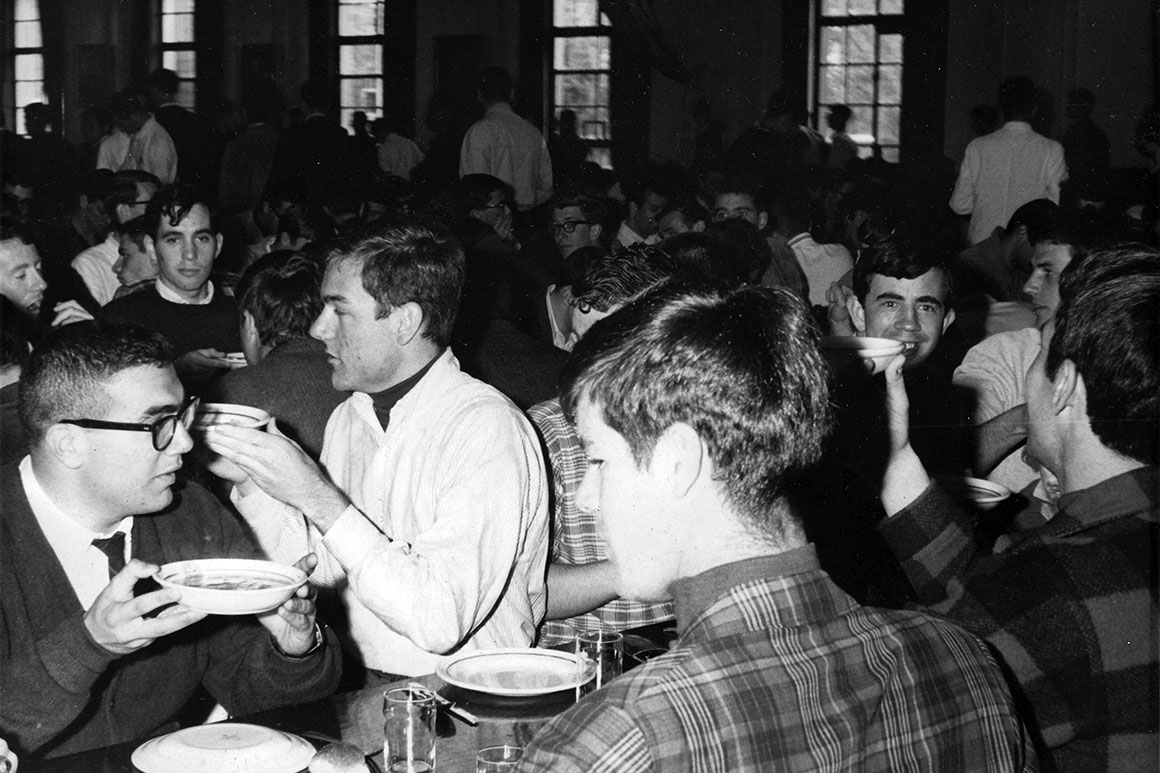
In "Thy Honored Name," Fr. Kuzniewski points to the 1922- 23 academic catalog as the first in which academic offerings were arranged "in fifteen groups that began to resemble modern academic departments": philosophy, political economy, pedagogy, jurisprudence, Latin, Greek, English, history, mathematics, biology, physics, chemistry, evidences of religion, modern languages, and oratory and elocution. Contrasted with the 2017- 2018 College Catalog, which lists more than 40 areas of academic study, it's clearly a trend that caught on!
Kimball's Surprising Souvenir

Kimball Hall opened in January 1935, designed to seat 888. Seated 12 at a table (six per side), following grace, diners were served by student waiters bearing serving platters. Each student took his portion before passing to the next. Dinners started with soup, followed by meat (fish on Fridays), potatoes, gravy, vegetables and dessert.
While the switch from family-style to cafeteria-style dining was made in 1971, today’s students still eat at one of the original 12- or 7-foot tables (86 in all), meaning generations of students — and families — have shared the same dining surface. Kimball was renovated in the 1990s and 2014, resulting in a food court-style, all-you-care-to-eat servery with plentiful meal options.
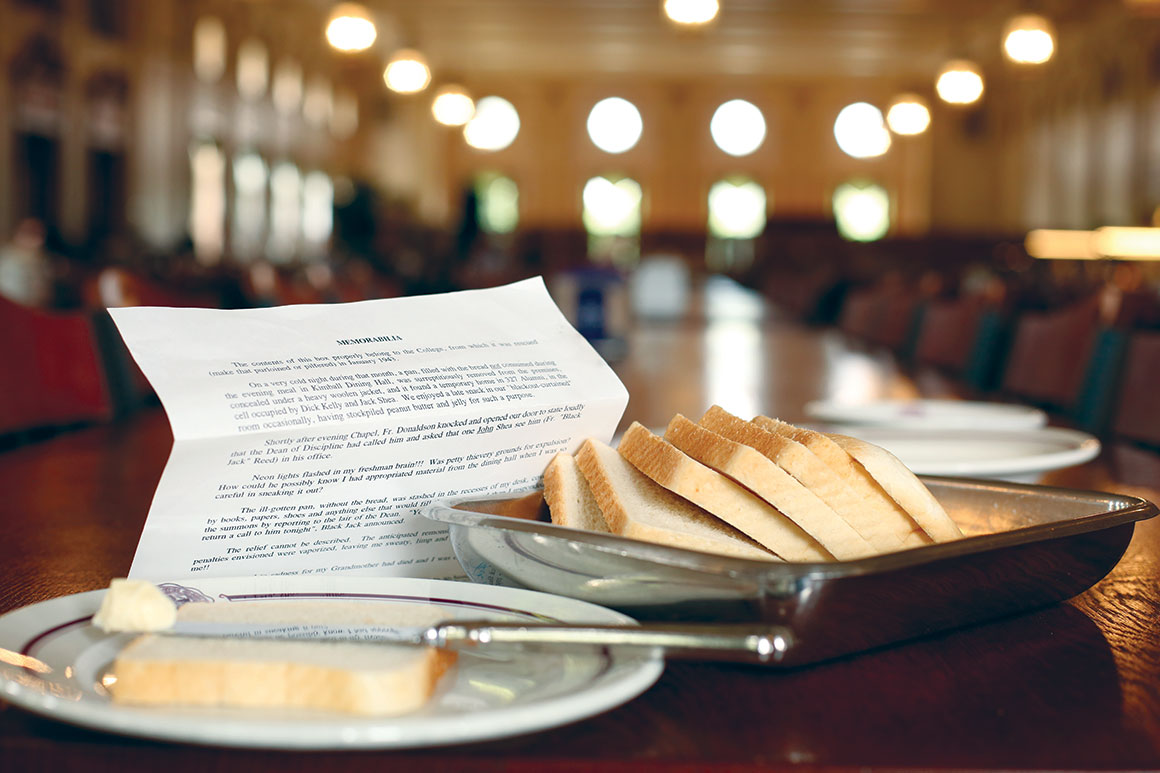
In June 1997, the College received an unexpected package containing a stainless steel bread pan — and a confession. In the accompanying letter, the late Jack Shea ’47, P73 admitted he smuggled the pan (and extra bread) out of Kimball and back to his room (Alumni 327) one night in January 1943, so he and his roommate could enjoy a future snack. Later that evening, Shea, to his horror, was summoned to the office of the dean of discipline, “Fr. ‘Black Jack’ Reed,” he recalled in his letter to the College.
“Neon lights flashed in my freshman brain! Was petty thievery grounds for expulsion? How could he possibly know I had appropriated materials from the dining hall when I was so careful sneaking it out?” Shea reported to the dean’s office, only to find out his father had called and wanted him to return the call: “The relief cannot be described!” Shea noted the pan left with him after he moved out that spring. “It has seen many ovens and tables since, and now has come full circle as I reunite it with its rightful owner, our College, knowing full well the statute of limitations will protect me from Jesuitical prosecution.”
Hooray for Hecuba
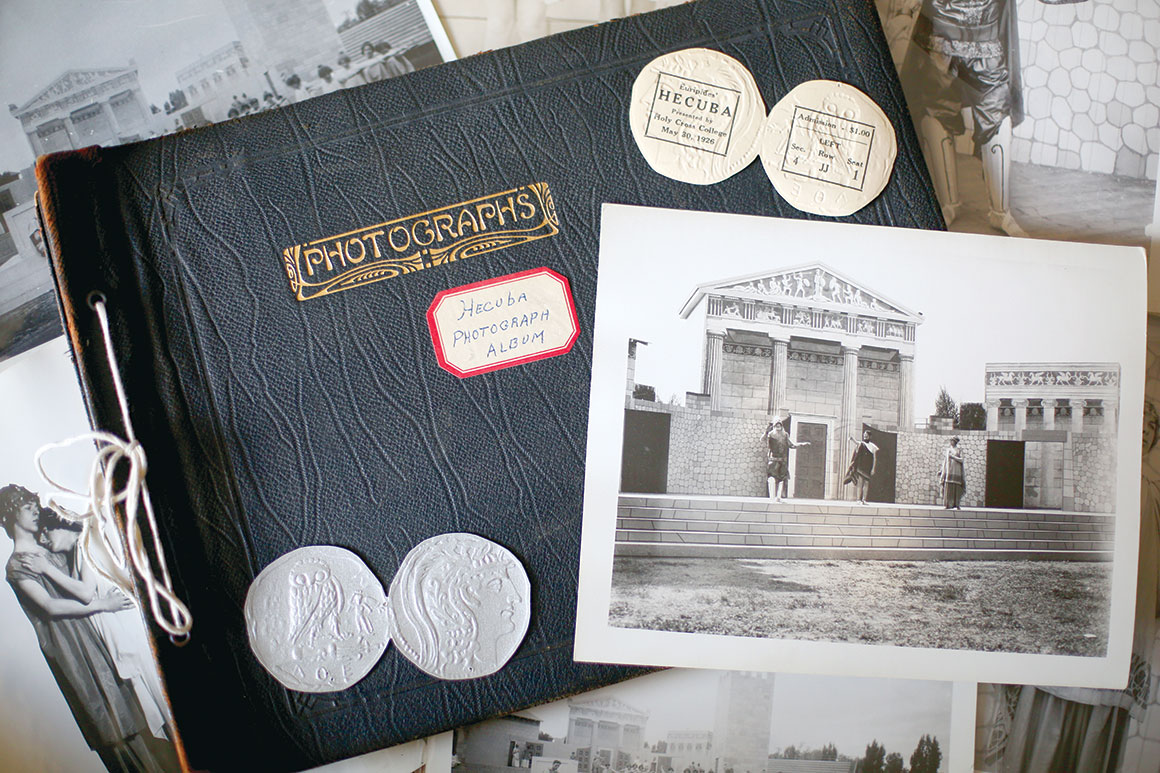
On May 30, 1926, 5,000 people paid $1 per ticket to pack Fitton Field, but the event had nothing to do with sports. Holy Cross students mounted a massive production of Euripides’ “Hecuba” in Greek, an endeavor that cost $10,000 — $137,000 in 2018 dollars.
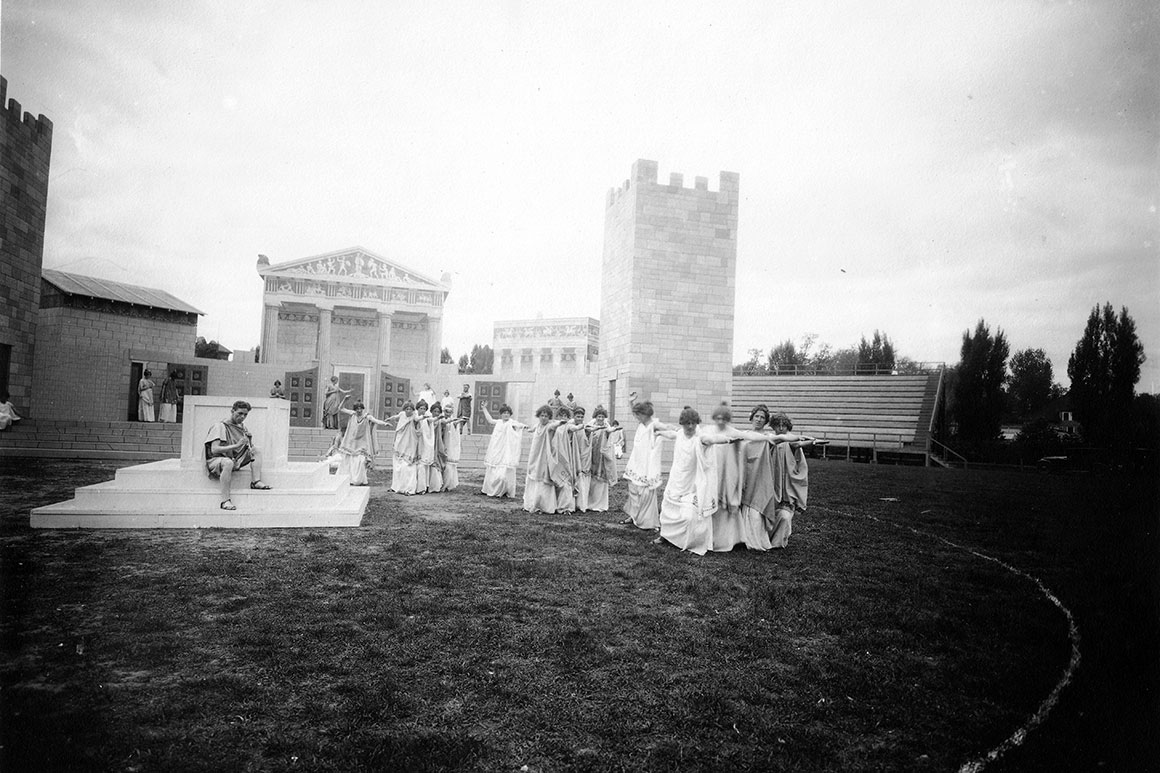
The play was such news it made the The New York Times, which noted: “Today’s audience sat in the stadium transformed into a structure similar to the original theatre and listened to the soft-flowing Greek … More than 1,000 yards of silk were used in costuming the players. The chorus of 15 players, some of whom were recruited from the freshman football squad, represented the captive women in the Grecian camp and revived two ancient choral dances.”
The love and promotion of the classics remains vibrant on campus today via the Holy Cross classics department, one of the largest in the country, and events such as Classics Day. This spring, the 46th annual event drew 300 New England high school students for a full day of activity, including a costume contest, art contest, trivia challenge, manuscript translations and more.
Crunchy Crusader
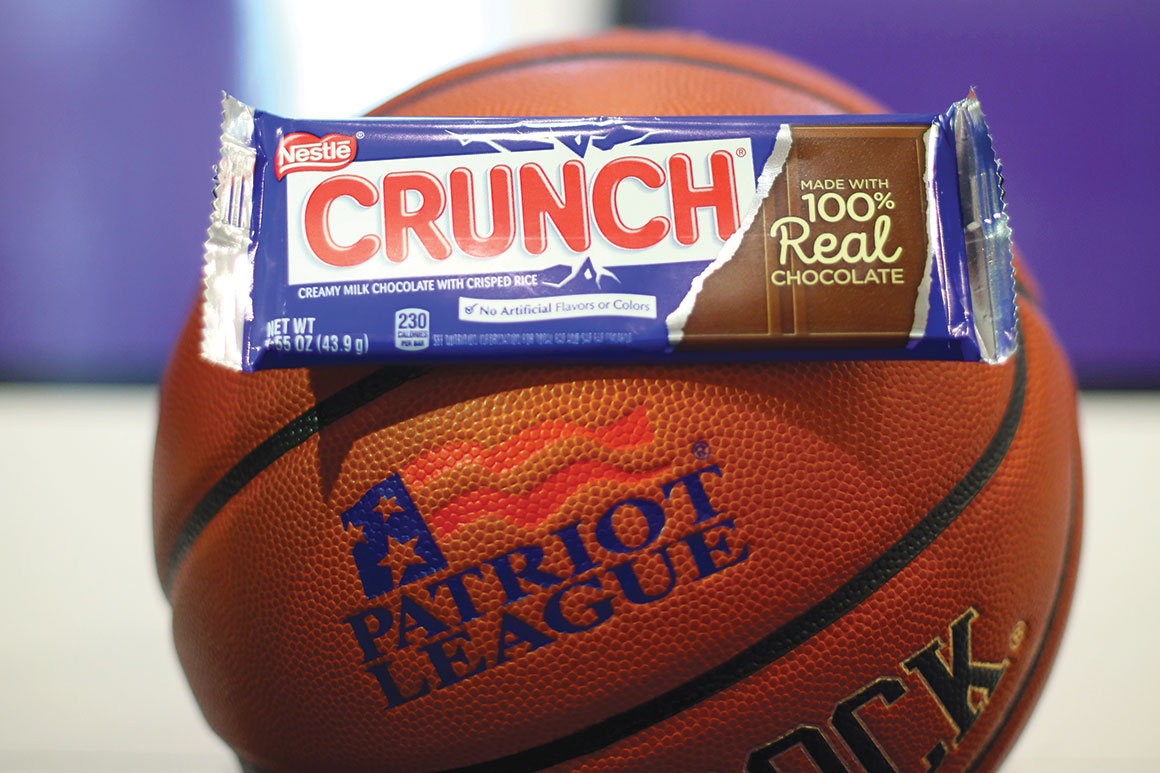
What does a Nestle Crunch bar have to do with Larry Bird? Better yet, what do either of them have to do with Holy Cross? Well, in 1987, Jim McCaffrey '86, P18 joined the three when he starred alongside the Celtics star in an ad for Nestle. However, the Hart Center record-holder wasn't shooting hoops with Bird, as you might expect.

"Bird was obviously playing for the Celts at that point," McCaffrey recalls. "I was trying out for the Celts, and we got toward the end of camp and essentially, they come to camp looking for someone to play in the commercial. The only caveat was that the janitor had to be short! The other guys who fit the bill height-wise didn't want to do it, so I ended up getting the part."
McCaffrey says he still gets comments on the ad, likely helped in no small part by being available on YouTube.
Watch the commercial here.
Back to the Future
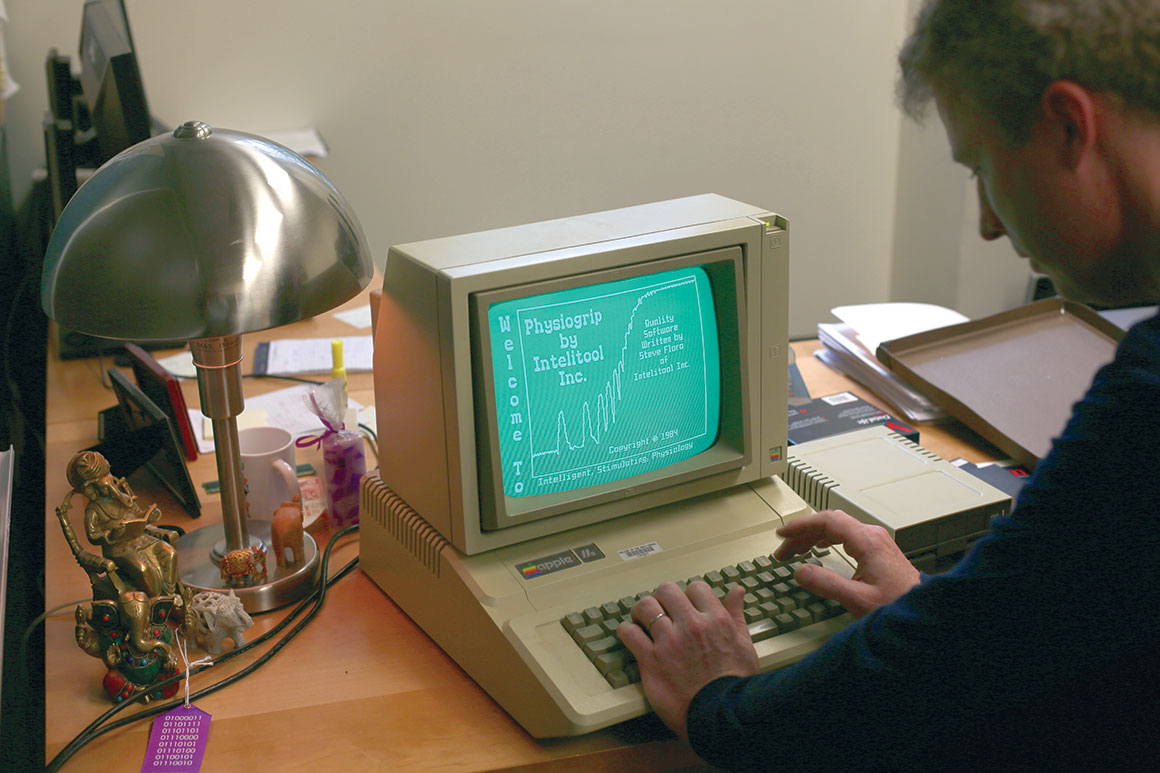
While this 1983 Apple IIe predates the founding of the computer science program in the 1990s and the 2004 establishment of the major, it is still quite valuable to today’s students. Assistant Professor Kevin Walsh collects “vintage” computer equipment and uses it in the department's Computer Systems and Organization course, which examines how computers are designed and operate. Students take apart old computers and components to understand how they are built and work, a task made more difficult with today’s technology, in which components are microscopic or often sealed and inaccessible. The popularity of computer science is on the rise on The Hill, with course enrollment nearly tripling over the past five years.
A Time of War

The United States’ entry into World War II changed life on the home front, and the Holy Cross campus was no exception. Traditional enrollment dropped sharply, but was bolstered by the addition of the Naval ROTC program and the branch’s V-7 and V-12 programs, which educated and trained students for service. Breaks and vacations were shortened and the academic year was revised and compressed to accelerate graduation. Three editions of a special NROTC yearbook, “The Crest,” were produced to celebrate the class of 1945 and two classes of 1946.
A powerful editorial in this December 1941 edition of The Salvo, the College’s official monthly Naval ROTC publication, anticipates the road ahead for students, sailors, soldiers and the United States.
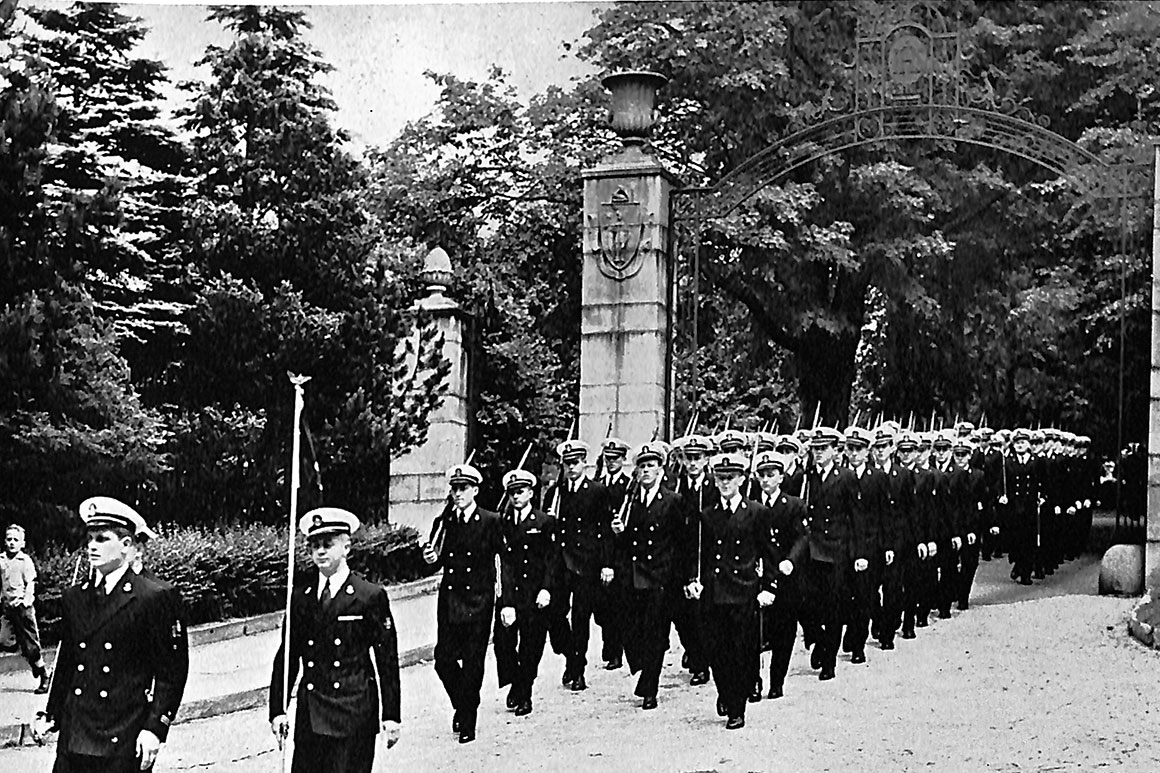
“Once again our Navy turns to fight a ruthless foe, and to fight this foe to a completely victorious end,” writes coeditor Leo Hession ’45. “Unstability [sic] of present affairs at home, the knowledge of grim and bloody battle before us, and the death of many of our friends and countrymen make our daily life one of anxiety, but in the shadow of those who have gone before, we stand fast, awaiting our orders whenever they may come.”
The war had an enormous impact on the College, particularly enrollment, which averaged 750 to 850 students for most of the war, compared to 1,200 in fall 1941. Nearly 4,000 Holy Cross alumni, students and faculty served; 109 gave their lives.
Holy Cross' International Fabric
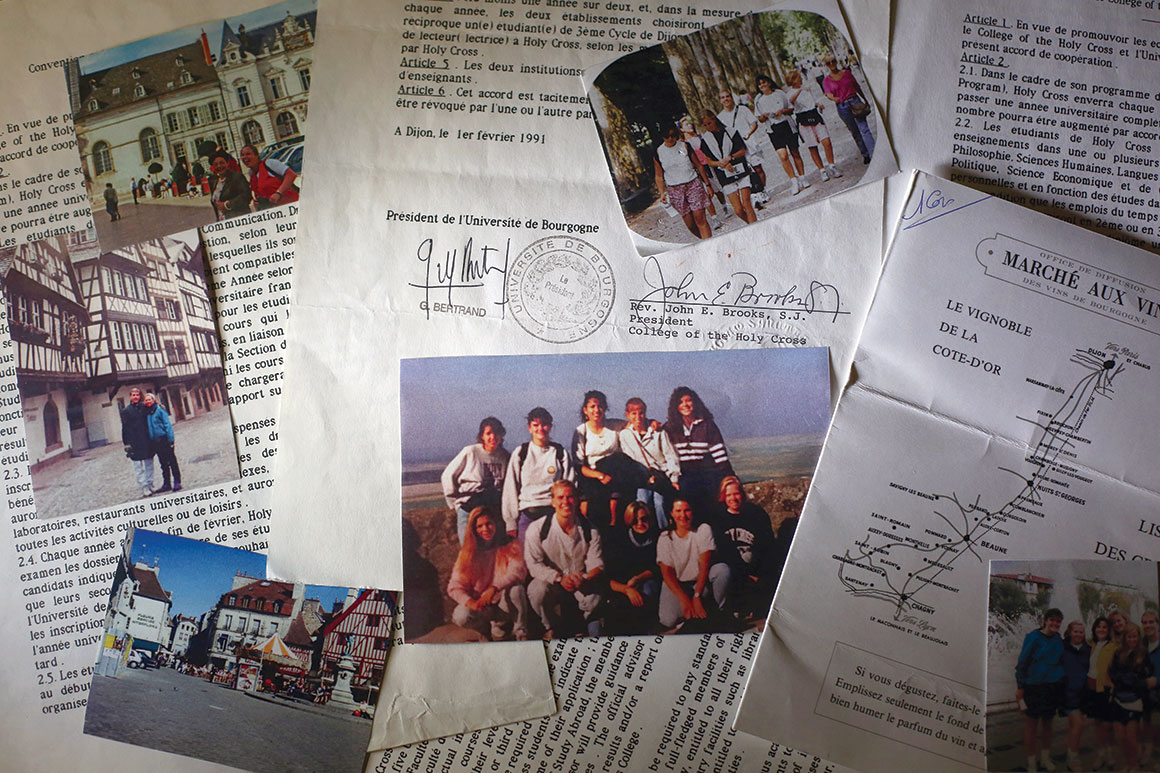
In fall 1991, a handful of Holy Cross students began the new academic year in the picturesque French cities of Dijon and Strasbourg — the sites of the College's first yearlong study abroad programs in non-English speaking countries. With language and cultural fluency as the goal of the first French programs — as well as those in Spain, Italy and the programs that followed — students took courses alongside their French classmates, participated in a four-week intensive language course beyond their two years of language prep at Holy Cross and lived with French host families.
The photograph above shows snapshots of the students abroad in Dijon and Strasbourg during that first academic year, alongside the original contract between Holy Cross and Dijon's Université de Bourgogne, signed by each respective president in February 1991.
The students' return to Mount St. James as more independent, inquisitive learners and conscientious global citizens fluent in French was not by happenstance, but rather the result of concerted efforts made by then-Director of Study Abroad Maurice Géracht and other administrators, who decided to do away with third-party intermediaries and directly enroll students in institutions abroad.
This model first took shape in 1989 with the establishment of Holy Cross' program at Mansfield College at Oxford University, where Holy Cross' pioneering approach served to introduce the visiting student program to the English college. These yearlong programs and study abroad philosophy continue to serve as the foundation for the 50 programs in 29 countries around the world that change the lives of hundreds of Holy Cross students each year.
An Unexpected Alteration
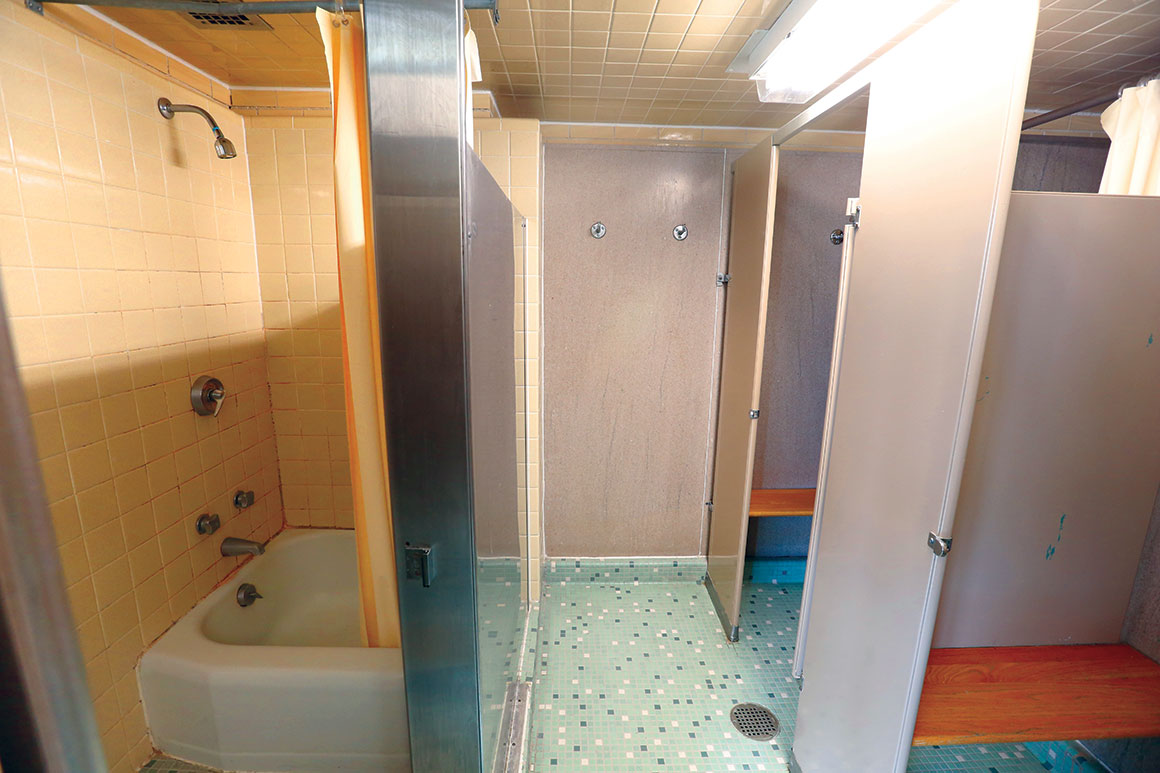
Many things changed on Mount St. James when the campus welcomed the first class of women through its gates, but not everything was modified in the ways folks expected. As Marilyn Boucher Butler, associate dean of students at the time, recalls, some administrators expected to make more radical changes than were necessary.
"One of the older Jesuit priests, who oversaw physical plant, had this idea that (he had done a lot of research) the showers needed to come out and bathtubs needed to be put in, so that the ladies could soak," Butler recalls.
This bathtub was installed on the fourth floor of Mulledy-Brooks (which was, at the time, the newest residence hall and, therefore, the first to go coed, according to Butler) before Butler was able to suggest that, yes, women did in fact take showers and would likely be just as happy with showers as with bathtubs.
Batting Up to the Majors
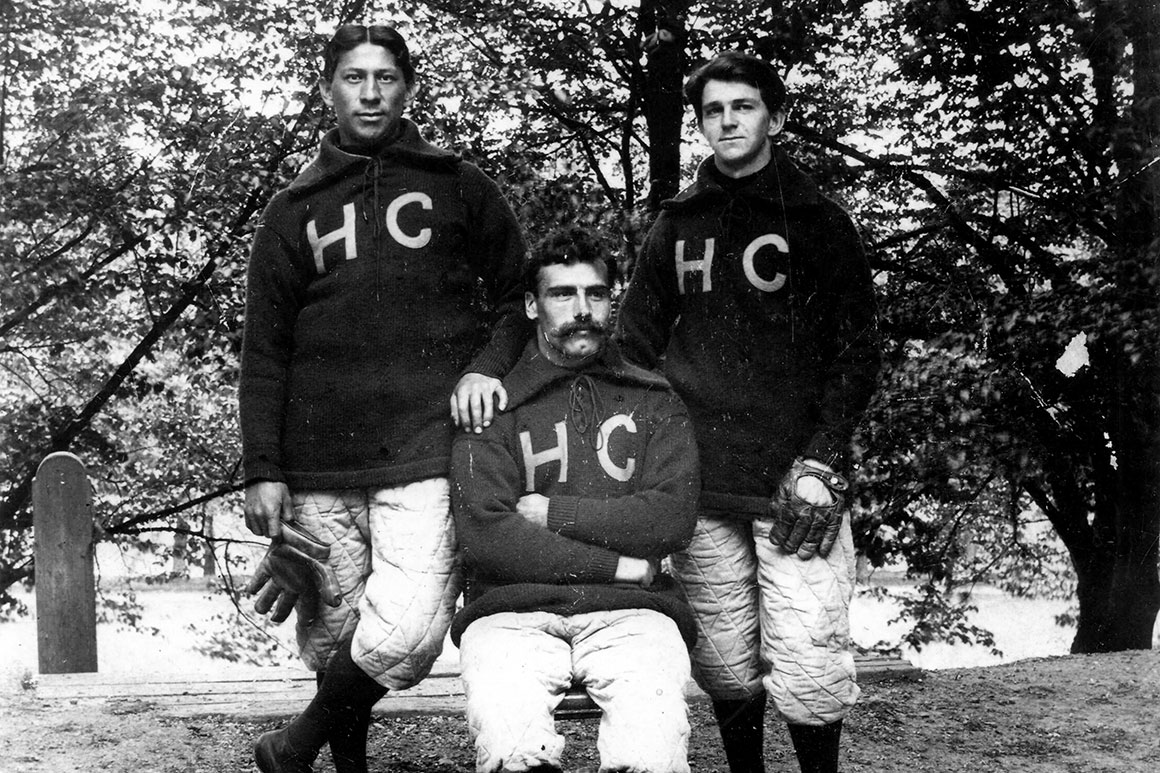
According to sports museum curator and author Richard Johnson, Holy Cross was among the top five colleges to send players to the baseball major leagues between 1890 and 1930. Among those primed on the College's first varsity team (established in 1876) was baseball giant Louis Sockalexis, a Penobscot Indian who attended the College's preparatory school in 1895 and 1896.
A crowning example from the era, Sockalexis rose to immediate stardom, hitting .436 in 1895 and .444 in 1896, and throwing two no-hitters during his two-year tenure at Holy Cross. Sockalexis, who became the first full-blooded Native American to play in the majors, joining the Cleveland Spiders in 1897, was one of thousands of students who have been shaped by the College's 27 varsity Athletics teams and, in turn, have shaped the history of Holy Cross and Athletics at large.
In the photograph above, Louis Sockalexis (left) stands with captain Mike "Doc" Power, class of 1897 and Walter Curley, class of 1898.
A Telecom Web

Located in the telephone room in the basement of Fenwick Hall, these wires represent the more than 1,000 telephone lines throughout campus, each connecting an extension to a building and then to the handset in that building. The College’s phone system is gradually being converted to voice over IP — phone service riding over the Internet — which will eliminate the wires one by one, as connections can be configured via software. It's no surprise that requests to turn on phone extensions in dorm rooms are nearly nonexistent today thanks to smartphone use.
Massachusetts' Best License Plate

As the longest-serving president (1970-1994) in College history, it’s no surprise Fr. Brooks is a large presence in the College Archives.
His achievements were groundbreaking and reverberate today, from his famous 1968 drive up and down the East Coast recruiting African-American students to attend his nearly all-white College and ushering in the first class of female students in 1972, to growing the school’s endowment, balancing budgets and playing a key role in establishing Holy Cross as a vibrant center for the arts. And, all that in addition to the personal relationships and impact he had on thousands of students, faculty and staff. Fr. Brooks’ boxes of personal effects in the College Archives clearly recount his accomplishments via everything from awards and keys to a city to this epic license plate, a gift from a student whose family was close friends with Fr. Brooks.
“The message on the plate fairly represented both the student's — and Fr. Brooks' — feeling on the matter!” Fr. Markey notes. “He had it prominently displayed on his sink in his room.”
On Air
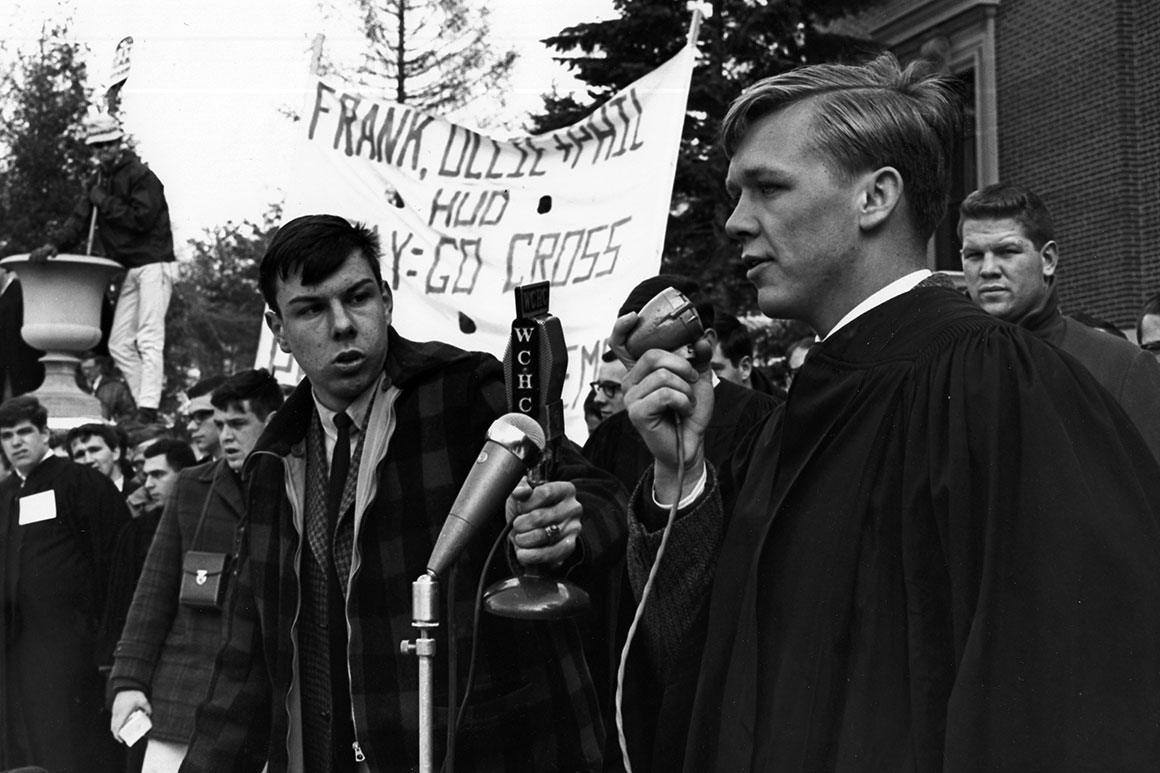
Monday, Dec. 6, 1948, marked the debut of WCHC, Holy Cross’ radio station. The two-hour inaugural broadcast played on Channel 645 AM and included a liturgical blessing from Rev. John A. O'Brien, S.J., then-College president. It wasn't until the 1970s that WCHC went public, broadcasting on 89.1 FM. On June 6, 1989, WCHC took over 88.1 FM, where it continues to broadcast today. Run primarily by students, the station prides itself as "Worcester's only alternative music station."

